
Discover the wonders of the cosmos: an astronomical schedule for the sun, planets, eclipses, stars, comets, meteors, clusters, nebulae.
Amateur stargazing involves individuals who lack formal training in astronomy. Similar to professional astronomers, hobbyists possess extensive experience in observing, researching, and astrophotography of various celestial objects. In fact, it is often the amateurs who showcase remarkable accomplishments in their field.
By using our telescope section, you can now experience the wonders of the universe firsthand through real-time online observations. This webpage offers a comprehensive set of tools including calendars, star maps, and expert tips to help you locate celestial bodies of your choice at any given time. Furthermore, our hints provide valuable advice on selecting the appropriate equipment and purchasing the ideal telescope to view specific astronomical objects.
The Stellar Calendar
Embark on an extraordinary journey through the universe with the help of our meticulously crafted celestial calendar. For the benefit of aspiring stargazers, we present to you a comprehensive guide to astronomical events:
The Stellar Calendar for 2019

Offering a user-friendly 2019 astronomical calendar for astrophotographers who don’t want to overlook the most captivating occurrences of this year.
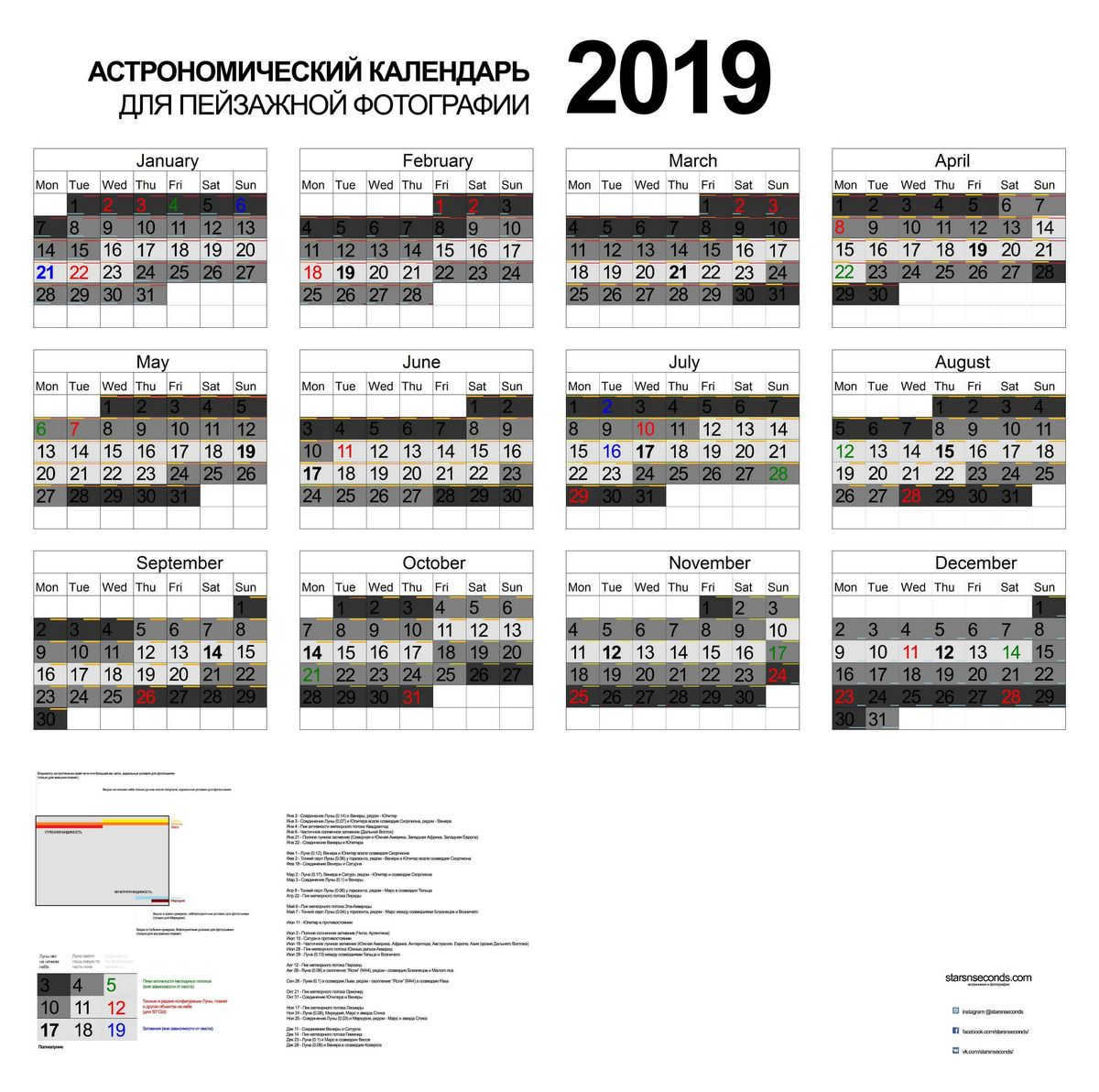
Don’t forget to click on the calendar to view it in its full size.
In the table format of each month, you will find a comprehensive list of upcoming astronomical events. It’s worth mentioning that certain dates are highlighted with squares in varying shades of dark, gray, and light gray. This serves as an indication of the moon’s illumination level during those nights. Additionally, different colors are used for the numbers on the calendar. Green signifies the peak activity of meteor showers, red points out uncommon locations of the Moon, planets, and other celestial bodies, while blue represents eclipses. Take a look at the example provided in the lower photo for further clarification.
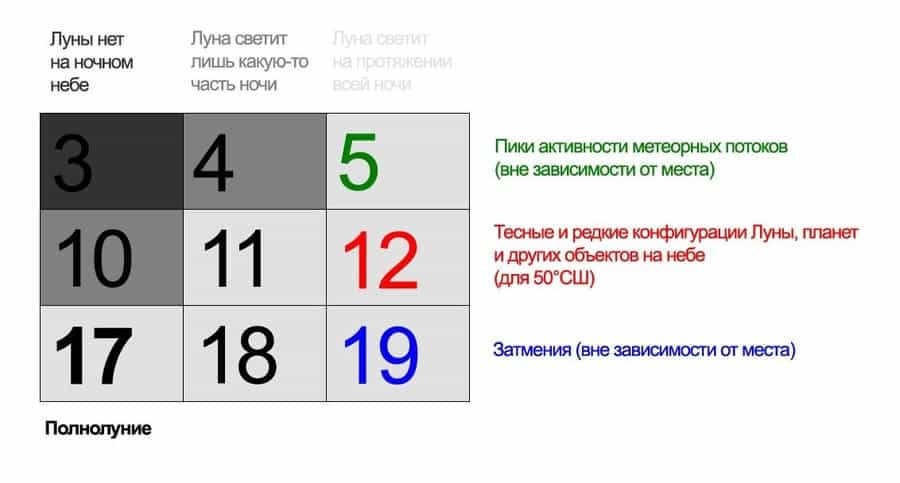
Let’s explore all the major astronomical events in 2019:
- January 2 – Conjunction of the Moon (0.14) and Venus, with Jupiter in close proximity
- January 3 – Conjunction of the Moon (0.07) and Jupiter near the Scorpio constellation, with Venus nearby
- January 4 – Peak activity of the Quadrantid meteor shower
- January 6 – Partial solar eclipse (Far East)
- January 21 – Total lunar eclipse (North and South America, West Africa, Western Europe)
- January 22 – Conjunction of Venus and Jupiter
- February 1 – Moon (0.12), Venus and Jupiter near the Scorpio constellation
- February 2 – Crescent moon (0.06) near the horizon, Venus and Jupiter near the Scorpio constellation
- February 18 – Venus and Saturn align.
- March 2 – Moon (0.17), Venus and Saturn, near Jupiter and the constellation of Scorpio.
- March 3 – Moon (0.1) and Venus align.
- April 8 – The Moon’s thin sickle (0.06) near the horizon, with Mars in Taurus nearby.
- April 22 – Peak of the Lyrid meteor shower
- May 6 – Peak of the Eta Aquarid meteor shower
- May 7 – Thin Sickle Moon (0.04) on the horizon, near Mars between Gemini and Ascendant.
- June 11 – Jupiter in opposition.
- July 2 – Total Solar Eclipse (Chile, Argentina)
- July 10 – Saturn in opposition
- July 16 – Partial lunar eclipse (South America, Africa, Antarctica, Australia, Europe, Asia (except Far East)
- On July 29, the Moon will be positioned between the constellations of Taurus and Ascendant, with a magnitude of 0.13.
- August 12 marks the peak of the Perseids meteor shower.
- On August 28, the Moon will have a magnitude of 0.08 and will be located near the cluster “The Nursery” (M44), close to the constellations of Gemini and Little Dog.
- On September 26, the Moon will have a magnitude of 0.1 and will be in the constellation Leo, near the cluster “The Nursery” (M44) in the constellation Cancer.
- October 21 is the peak of the Orionid meteor shower.
- On October 31, there will be a conjunction between Jupiter and Venus.
- November 17 marks the peak of the Leonids meteor shower.
- On November 24, the Moon will have a magnitude of 0.08 and will be accompanied by Mercury, Mars, and the star Spica.
- On November 25, the Moon will have a magnitude of 0.03 and will be in conjunction with Mercury, with Mars and the star Spica nearby.
- December 11 will see a conjunction between Venus and Saturn.
- On December 14, the Geminid meteor shower will reach its peak.
- On December 23, there will be a conjunction of the Moon (0.1) and Mars in the constellation Libra.
- On December 28, there will be a conjunction of the Moon (0.08) and Venus in the constellation Capricorn.
It is important to note that in today’s world, astrophotography (taking photos of space and celestial objects) and observational astronomy are considered part of amateur astronomy. As a result, there are certain space objects that are traditionally of interest to non-professionals:
Objects available for observation
The Sun
Observing solar activity, flare fields in areas of magnetic activity, prominences, sunspots, solar cycles, and other phenomena.
The Moon
With telescopes ranging from 60 to 500 mm, you can explore the current state of the Moon and examine the details on the surface of Earth’s only satellite, such as valleys, mountains, craters, and seas.
The Planets
There is a constant change in the details visible on planetary disks. Venus and Mercury exhibit phases of illumination, and infrared imaging provides insights into the atmosphere of Venus. Amateur astronomers can observe seasonal transformations of polar caps, active dust storms, surface colors, and sporadic clouds on Mars. Jupiter’s atmosphere is also known for its instability, with the Great Red Spot being a particularly noteworthy feature.
Saturn’s atmosphere may not be particularly fascinating, but its renowned rings are truly breathtaking. Utilizing amateur instruments, it is possible to observe the disks of Uranus and Neptune.
Eclipses
Individual solar and lunar eclipses can be witnessed once or twice at a specific location. Full solar eclipses occur at a given point approximately once every 250 years.
Deep space objects
Nebulae, globular and open star clusters, galaxies.
Binary stars
These are pairs of stars that appear close together when viewed from Earth.
Comets
A great many amateur stargazers opt to observe comets, whose behavior rarely conforms to strict predictions. In this case, observers can examine the brightness, degree of condensation, size of the coma, length and angle of the positional tail, and the brightness of the comet’s nucleus.
Meteors
Typically, amateur astronomers study shooting stars (meteors) during the peak activity of major meteor showers such as the Perseids, Quadrantids, Geminids, and Leonids. They usually analyze parameters such as the time of appearance, direction and speed of movement, brightness, length of visible path, color, residual phenomena, and flight time. Currently, the field of radio observations of meteor showers during the daytime is actively developing.
Asteroids
Visualized as objects shaped like stars without any noticeable size or details. They can be differentiated from stars due to their quick movement across the sky. The brightness of asteroids can vary constantly because of the dark and light spots on their surface, as well as their irregular shape.
Weather phenomena
Auroras, Silvery Clouds, Atmospheric Halo.
Accomplishments of Non-Professional Astronomers
You may have reservations about the ability of non-professional astronomers to make noteworthy astronomical findings. However, the evidence speaks for itself. Take, for instance, the case of William Herschel, who, despite being trained as a musician, was able to discover the planet Uranus through his passion for astronomy. Similarly, at just fourteen years old, Caroline Moore became the youngest female astronomer to detect the supernova star SN 2008ha in the Pegasus constellation within the UGC 12682 galaxy. Additionally, Carl Ludwig Henke, while working at the Prussian post office, came across two asteroids in 1803 and 1830.
So, you have the opportunity to make a significant impact by engaging in the fascinating field of amateur astronomy. Utilize the website’s valuable tips on observing planets, stars, the sun, nebulae, meteors, and comets to uncover new discoveries in the vast universe or capture stunning photographs of the cosmos for personal enjoyment, scientific research, or to promote the study of cosmology. While you may not reach the level of the Hubble Telescope’s photographs, history has shown that amateur astronomers have made numerous groundbreaking discoveries that have propelled the field of science forward. Join the ranks of these fortunate individuals.
Astronomy Calendar Archive:
- Astronomical Calendar for May 2015;
- Astronomical calendar for June 2015;
- Astronomical calendar for July 2015;
- Astronomical calendar for August 2015;
- October 2015 Astronomical Calendar
- November 2015 Astronomical Calendar
- December 2015 Astronomical Calendar
- January 2016 Astronomical Calendar
- February 2016 Astronomical Calendar
- March 2016 Astronomical Calendar
- 2018 Astronomical Calendar

The occurrence known as a solar eclipse can be defined as a celestial event where the Sun, Moon, and Earth are aligned in such a way that the Moon casts its shadow on the Earth’s surface, partially or totally obscuring the Sun’s light. This phenomenon is characterized by its uniqueness and has captivated human beings for centuries.
One of the most fascinating aspects of a solar eclipse is the time of its occurrence. It is important to note that these events do not happen frequently and are considered rare natural occurrences. The formation of a solar eclipse follows a specific scheme, where the Moon’s orbit intersects with the Earth’s orbit around the Sun. This alignment creates a shadow path, also known as the path of totality, where the total eclipse is visible.
For those interested in witnessing this breathtaking event, it is essential to consult the solar eclipse calendar, which provides information on upcoming eclipses. The calendar includes details such as the date, time, and location where the eclipse will be visible. There are different types of solar eclipses, including total, partial, and annular, each with its own unique characteristics.
When observing a solar eclipse, it is crucial to take precautionary measures to protect your eyes from the Sun’s harmful rays. Specialized solar viewing glasses or telescopes fitted with solar filters are necessary to safely observe the eclipse. Additionally, capturing photographs of a solar eclipse can be a rewarding experience, allowing you to preserve the memory of this extraordinary celestial event.
A total or partial obstruction of sunlight directed to the Earth occurs during a solar eclipse when the Moon’s disk is projected onto the Sun. This celestial event takes place exclusively during the New Moon phase when the side of the Moon facing us remains unilluminated. It should be noted that, similar to the Moon’s phases, the Sun also goes through eclipse patterns and phases, namely total or partial. During a total solar eclipse, one can observe the solar corona, which resembles a ring. The concept of a solar eclipse should now be clear, especially considering that it is the most easily observable astronomical phenomenon.
Solar eclipse schedule
The schedule of solar eclipses provides information about the dates and years of upcoming solar eclipse occurrences. You can observe the optimal viewing locations on Earth, including the point of maximum phase and the extent of the solar eclipse coverage. Additionally, you have the option to visit individual solar eclipse pages for descriptions, additional information, photographs, and the frequency of solar eclipses.
Upcoming solar eclipse on August 11, 2018
2019 Solar Eclipses
The solar eclipses of 2019 occurred in the northeastern part of Asia and the northern part of the Atlantic Ocean.
One notable solar eclipse took place on July 2, 2019.
Another significant solar eclipse occurred on December 26, 2019.
2020 Solar Eclipses
The solar eclipses of 2020 were visible in Africa, southeastern Europe, and Asia.
A noteworthy solar eclipse happened on December 14, 2020.
Understanding the Fundamentals of Solar Eclipses
A solar eclipse is an awe-inspiring event that captivates the attention of countless observers. However, the terminology and stages associated with this celestial phenomenon can sometimes be confusing for those new to astronomy. In this article, we will explore these concepts in detail and familiarize ourselves with the conditions required for a solar eclipse to occur.
Saros (from the Greek word “soros”) or draconic period refers to a specific time interval during which lunar and solar eclipses occur in a repeating sequence. This repetition is caused by the consistent alignment of the Moon, its orbital nodes, and the Sun. References to Saros can be found in ancient texts from Greece and Egypt, dating back several centuries B.C. The duration of a draconic period is approximately 585 and 1/3 days, which is equivalent to 18 years and 10 1/3 days (or 11 1/3 days in a leap year). Within one Saros, there are typically 28 lunar eclipses and 43 solar eclipses, including 15 partial, 2 annular-complete, 14 annular, and 12 total eclipses. However, the number of eclipses can vary in different periods due to specific circumstances. Based on the knowledge of the draconic period, astronomers can make preliminary predictions about future eclipses. Nevertheless, accurately predicting the exact timing and location of these celestial events remains challenging.
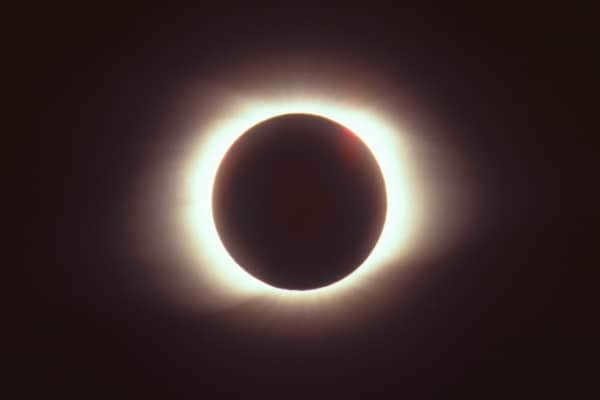
A partial solar eclipse is a type of solar eclipse where the Moon’s penumbra crosses the Earth’s surface. Unlike a total solar eclipse, the cone of shadow does not touch the Earth’s surface.
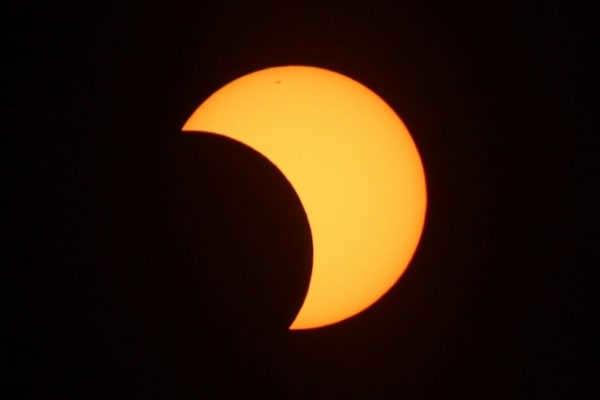
The Annular Solar Eclipse (also known as the Circular Solar Eclipse) occurs when the Earth’s surface is crossed by a cone-shaped continuation of the Moon’s shadow. During this type of eclipse, the Moon is positioned at a distance from the Earth that allows it to completely cover the Sun. The peak of the eclipse is characterized by the minimal distance between the axis of the Moon’s shadow and the center of the Earth.
The region on Earth where the maximum phase of an eclipse can be observed is known as the point of greatest eclipse. In the case of an annular eclipse, the point of maximum duration may or may not align with the point of greatest eclipse. The maximum duration of such an eclipse occurs either at the start or end of the eclipse path.
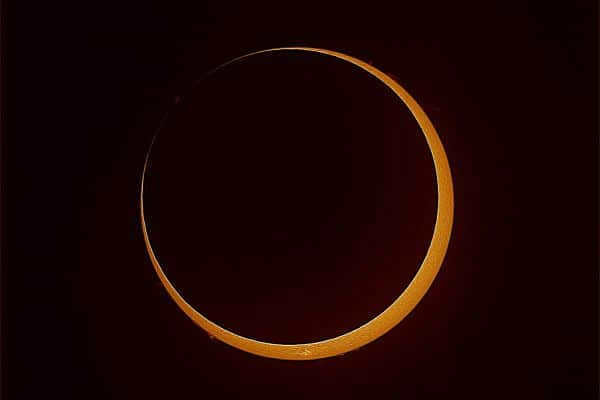
The Hybrid Solar Eclipse is a unique phenomenon where the Earth’s surface is intersected by the tip of the Moon’s shadow cone along the eclipse path. This intersection can cause the eclipse to shift from being total to annular, or vice versa. Due to this characteristic, hybrid eclipses are sometimes referred to as annular-full eclipses. It is common for hybrid eclipses to transition twice during their path, with the beginning and end being annular and the middle part being total.
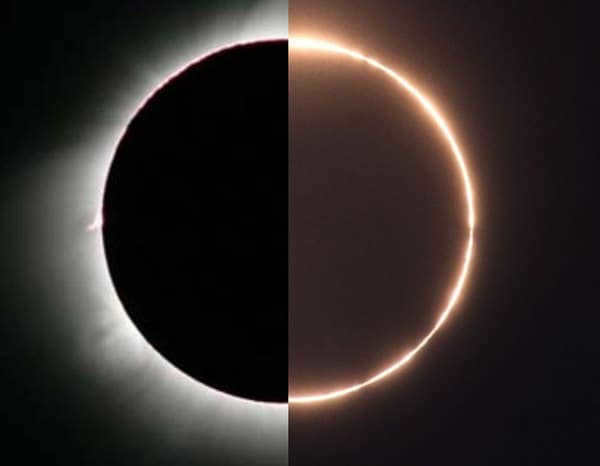
During an annular eclipse, the maximum duration may or may not occur at the same time as the maximum eclipse. This type of eclipse can have its longest duration at the start or end of its path.
In a total solar eclipse, the maximum eclipse coincides with the maximum duration and the most intense phase of the eclipse.
Guide to Safely Viewing Solar Eclipses
Many people are unfamiliar with the proper way to observe a solar eclipse, whether it is in Russia or anywhere else in the world, especially when it comes to a major event. Is it necessary to purchase a specialized telescope or search for filters? There are fundamental guidelines that must be followed in order to prevent any harm to your eyesight.
When using optical instruments to directly observe the solar disk, it is possible to cause irreversible damage to the retina. This risk even applies to observing phenomena like Bailey’s rosary or the solar crescent moon. The brightness of just one percent of the visible surface of the Sun is tens of thousands of times greater than that of the full Moon. This means that looking directly at the Sun through a lens is similar to using a magnifying glass to focus the Sun’s rays onto the retina, causing damage that is essentially irreparable even with surgery. Therefore, it is of utmost importance to always use proper eye protection when looking at the Sun. The only exception to this rule is during the total solar eclipse phase.
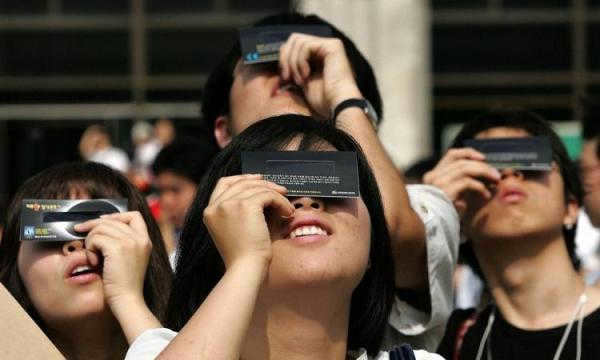
When strolling through town on a sunny day, Polaroid or regular sunglasses may provide some relief to the eyes. However, they should never be used for observing the Sun as they do not act as filters for light.
During a total solar eclipse, the Sun’s surface is completely covered, allowing observers to safely witness this awe-inspiring phenomenon without the need for specialized filters.
Various safe methods have been developed to observe the partial phase of a solar eclipse.
One such method is the point projection method.
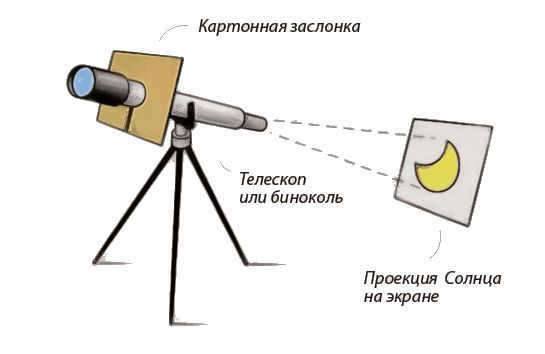
Observing the Sun in action can be done using the spot projection method.
It is important to note that viewing the Sun directly through a hole is not recommended.
Using light filters to observe solar radiation
Another technique for observing the Sun is by using specialized light filters. These filters are designed to only allow a small portion of sunlight to pass through. More information about these modern filters can be found in astronomy publications.
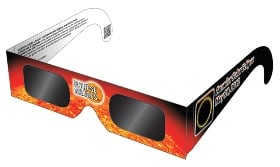
Unique glasses crafted from aluminized polyester material
Aluminized polyester is the main component used in producing certain types of filters. It is important to note that polyester, being a type of plastic, can have variations in density. To ensure complete protection for your eyes, it is crucial to carefully inspect the polyester for any tiny holes that could potentially allow sunlight to pass through and impair your vision. By using a high-quality light filter, you can confidently observe the radiance emitted by an intense incandescent lamp filament.
Alternatively, there are light filters made from black polyester. This particular material enhances the appearance of the light source, presenting it in pleasing yellow-orange hues. However, it is essential to reiterate that no filter can guarantee absolute eye safety if its density is lower than 5.0.
Avoiding close and prolonged observation of the Sun is crucial in any situation. Even if you use a filter, it is recommended to only view the Sun for short intervals. It is important to periodically take breaks and rest your eyes to ensure their well-being.
Using binoculars for observation
Astronomer writer George Lovie had a fascination with observing total eclipses using binoculars. Any type of binoculars can be used for this purpose. However, Lovie preferred to use 7×50 binoculars. In his written observations, he described the experience as such: “Even the most skilled photographers cannot accurately capture the colors and intricate details of the Sun during an eclipse. No camera film can capture the subtle features of the corona. Only the human eye is capable of such remarkable abilities.” According to Lovie, those who strive to capture the true essence of a solar eclipse through art are reminiscent of the artists of the 19th century. These artists witnessed this enchanting phenomenon firsthand and immortalized it on canvas, creating magnificent “astronomical” masterpieces.
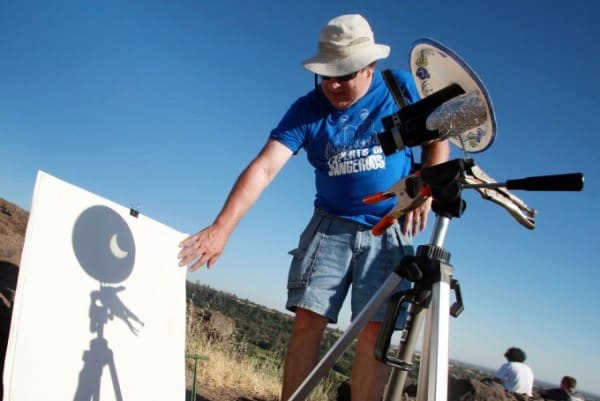
In the process of observing a solar eclipse, Joel Zdepski demonstrates the use of binoculars.
The author emphasizes the importance of exercising caution when using binoculars to observe an eclipse. He asserts that it is possible to view a total eclipse without filters using binoculars, telescopes, or even the naked eye. However, it is crucial to use a filter when observing partial phases of an eclipse, up until the appearance of a bright area around the darkened disk. Once this area disappears, the filter can be removed. It is important to resume using the filter when a bright glow appears on the western edge of the lunar disk and when the total eclipse begins to wane.
Observing the Eclipse with a Telescope
Ruth Freitag, a historian of astronomy, along with other observers, is using a compact mobile telescope to observe the eclipse. This telescope is highly stable and allows for extended periods of exploration without causing fatigue. Additionally, it provides a clearer and more detailed image of the eclipse. When a total eclipse occurs, the light filters on the telescope can be easily removed. Furthermore, if you desire a larger view of the corona, you can adjust the scale of the finder.
Filters for Camera and Telescope
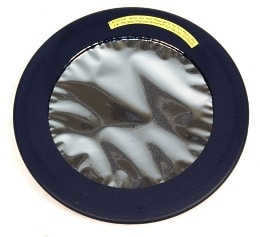
Several manufacturers of cameras and telescopes offer filters made of metal coating. These filters are known for their high level of safety when observing the Sun. Generally, they are more expensive compared to regular filters, but they are highly favored by amateur astronomers due to their ability to produce a yellow-orange image of the Sun. On the other hand, aluminized Mylar filters present the Sun in bluish gray shades.
It is important not to confuse filters designed for mounting on telescope apertures or camera lenses with solar eyepieces for telescopes. Some models of amateur telescopes still include the latter. However, their safety is heavily debated as they tend to quickly overheat, crack, and allow direct sunlight into the observer’s eyes.
Using fully developed black-and-white film as a light filter
An observation filter can be created DIY-style using genuine black-and-white film. It is recommended to use Pan-X or Kodak Tri-X film for this purpose. When the film is developed, a layer of silver is formed, which provides protection for the eyes.
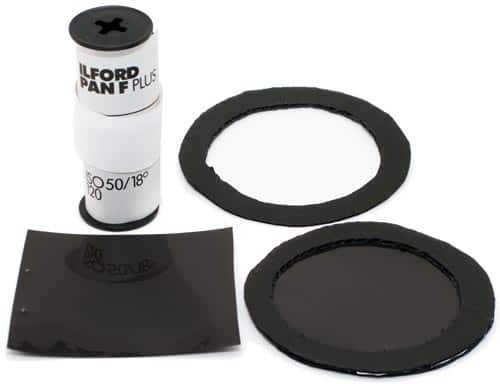

Creating a basic light filter using black-and-white film
The process of creating a filter is straightforward. Start by unraveling a roll of black-and-white film and exposing it to sunlight for a few minutes. Then, develop the film to produce negatives. Using two layers of negatives can serve as an effective filter for safely observing the sun without any harm to your eyes. For added precaution, it is recommended to create this filter a couple of days prior to the observation.
Avoid using chromogenic black-and-white or color film as they contain only colored dyes that do not provide adequate eye protection. By following these guidelines, you can capture stunning photos of solar eclipses, as showcased in the examples below.
Photographs taken by amateur astronomers of the solar eclipse: 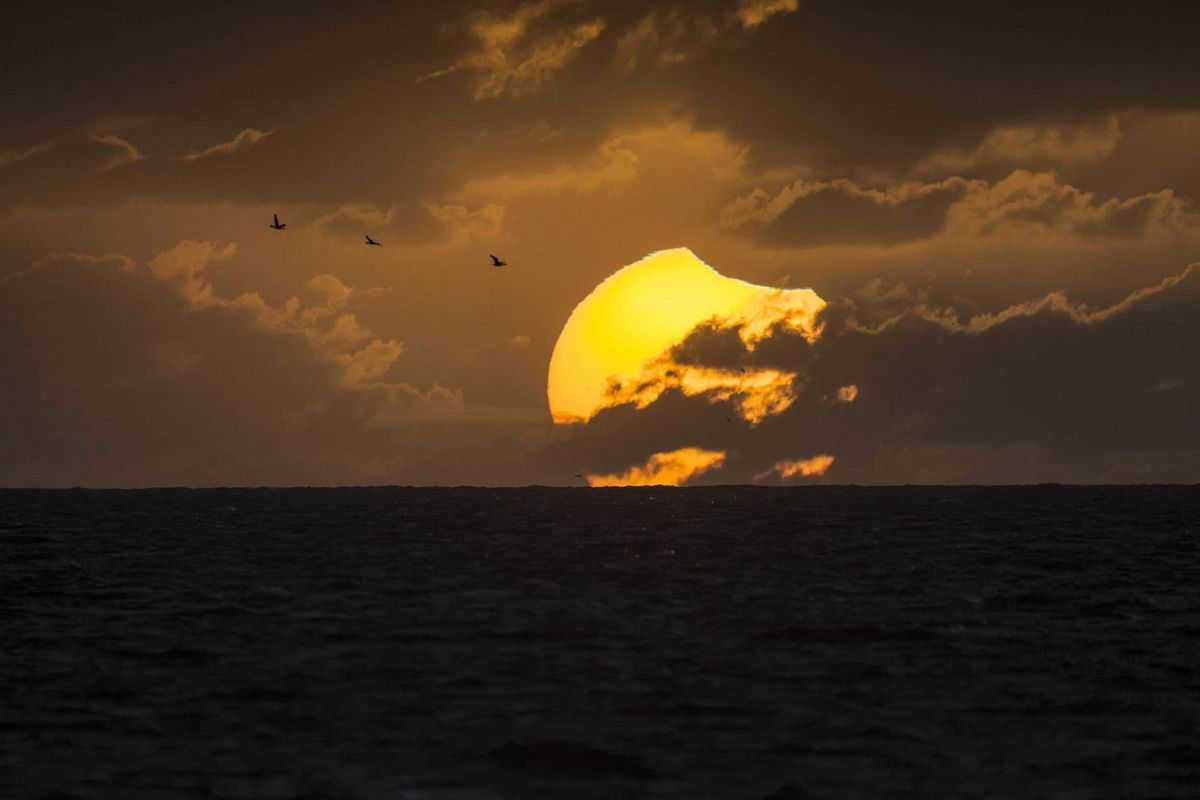
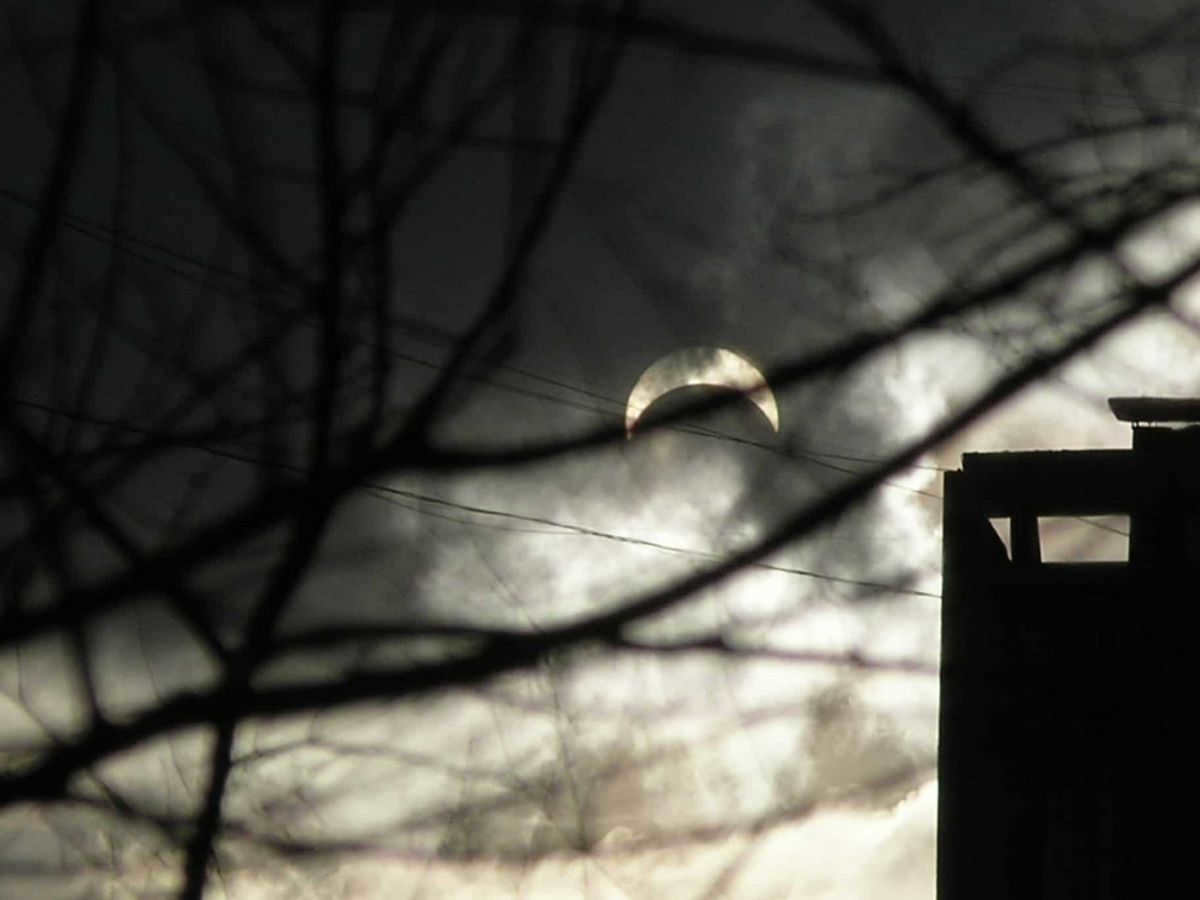
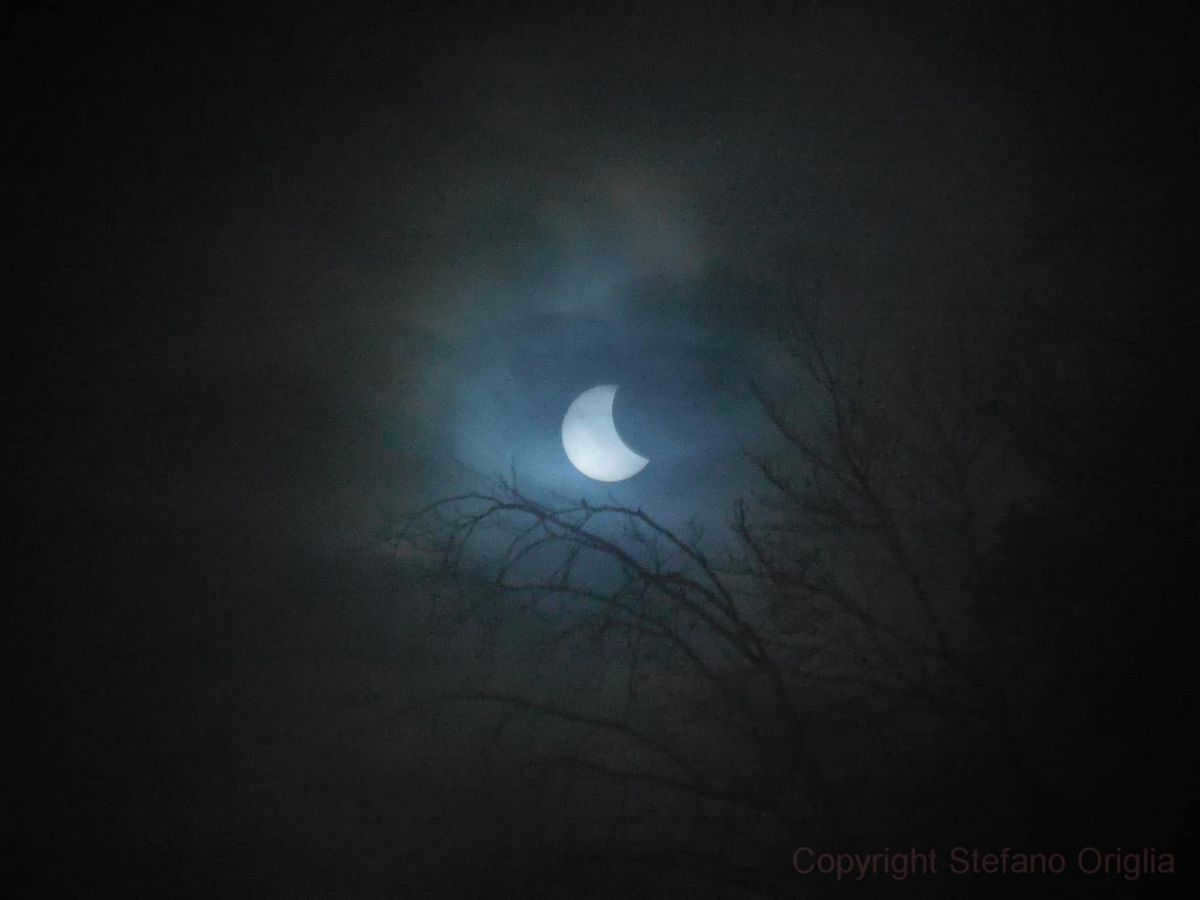
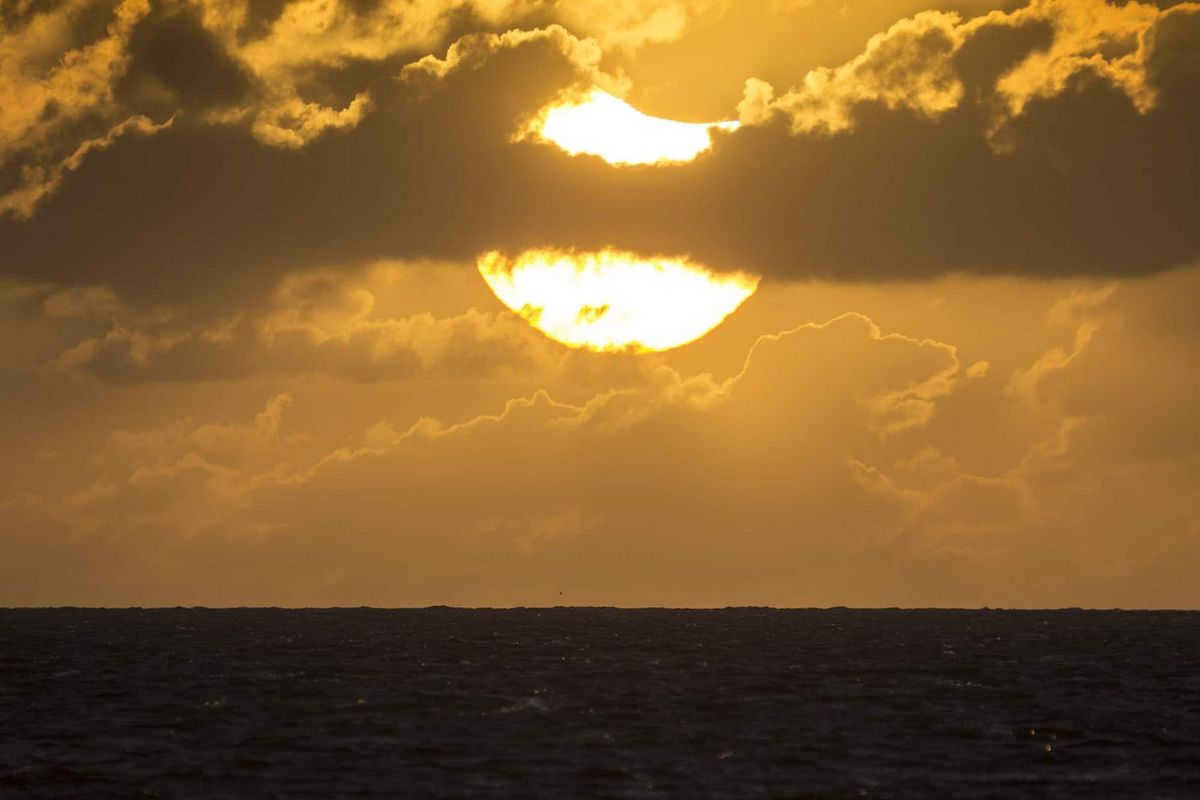
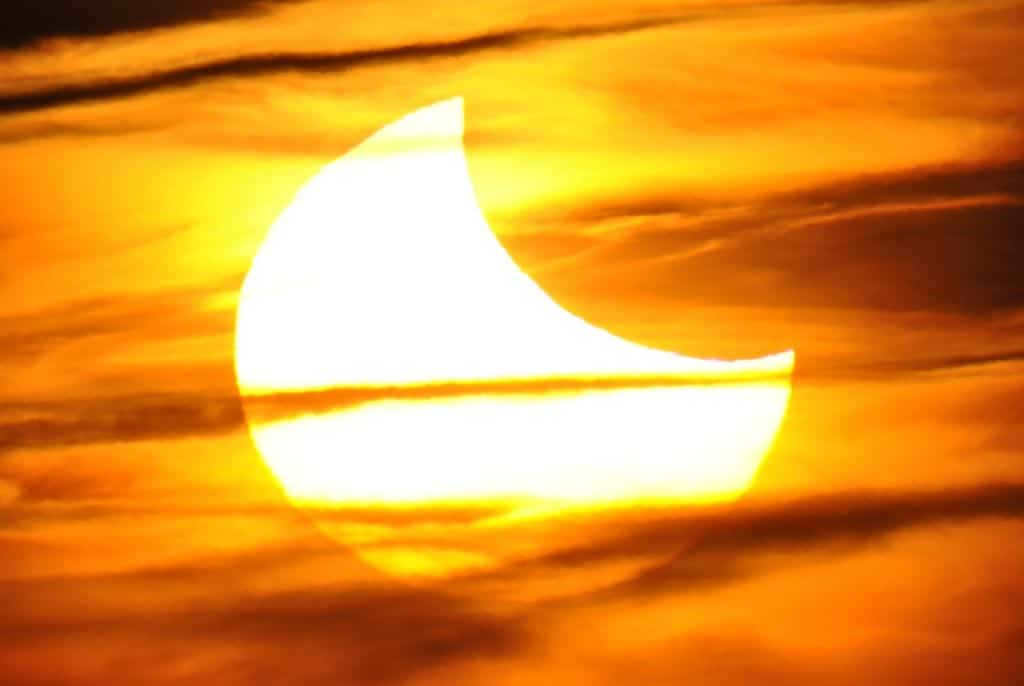
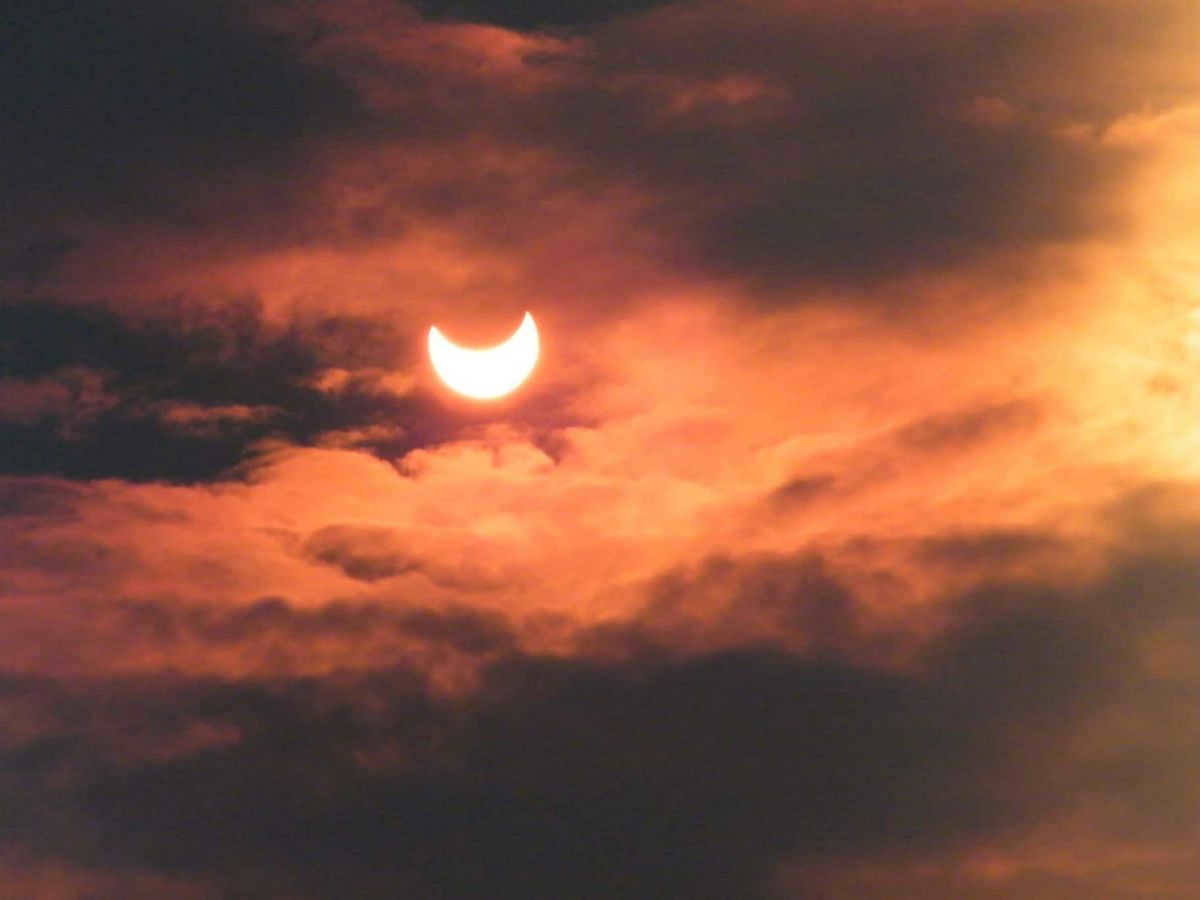
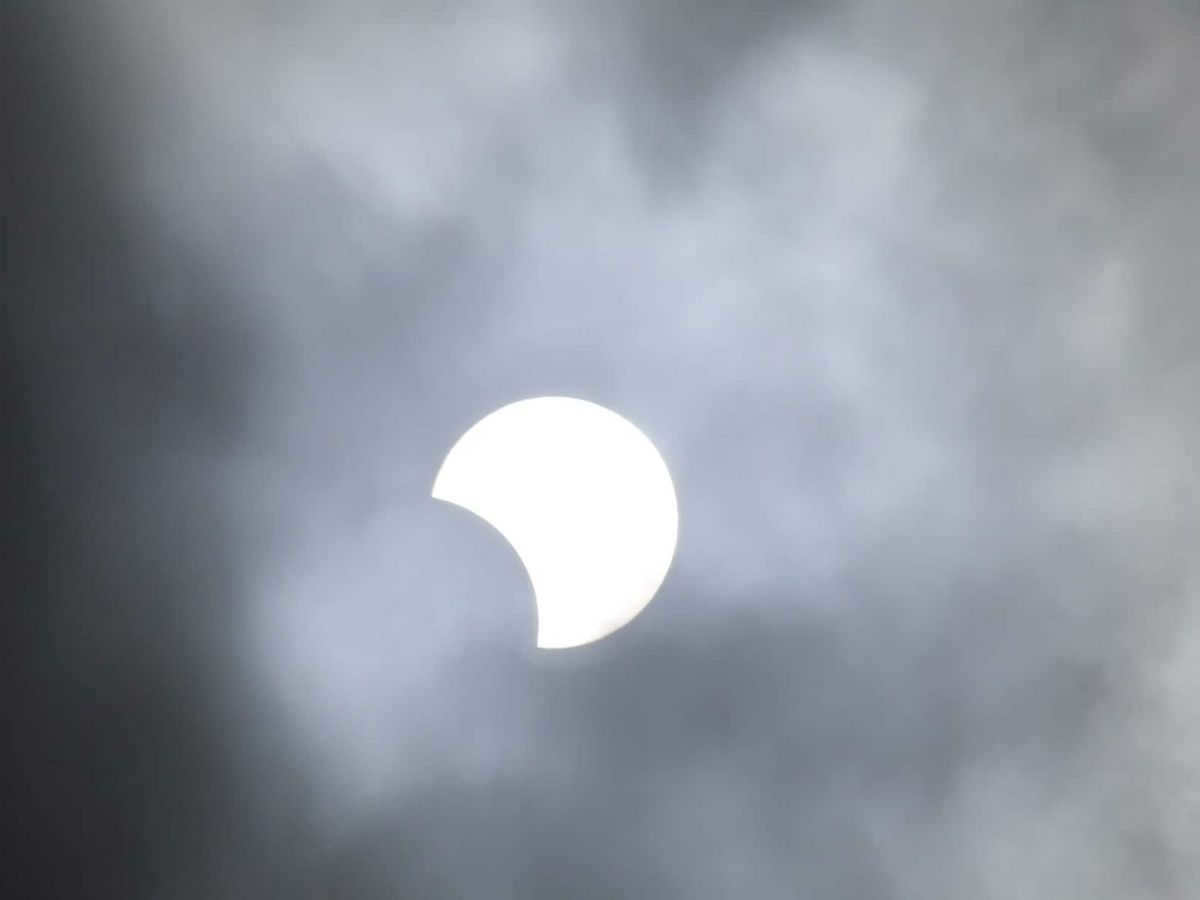
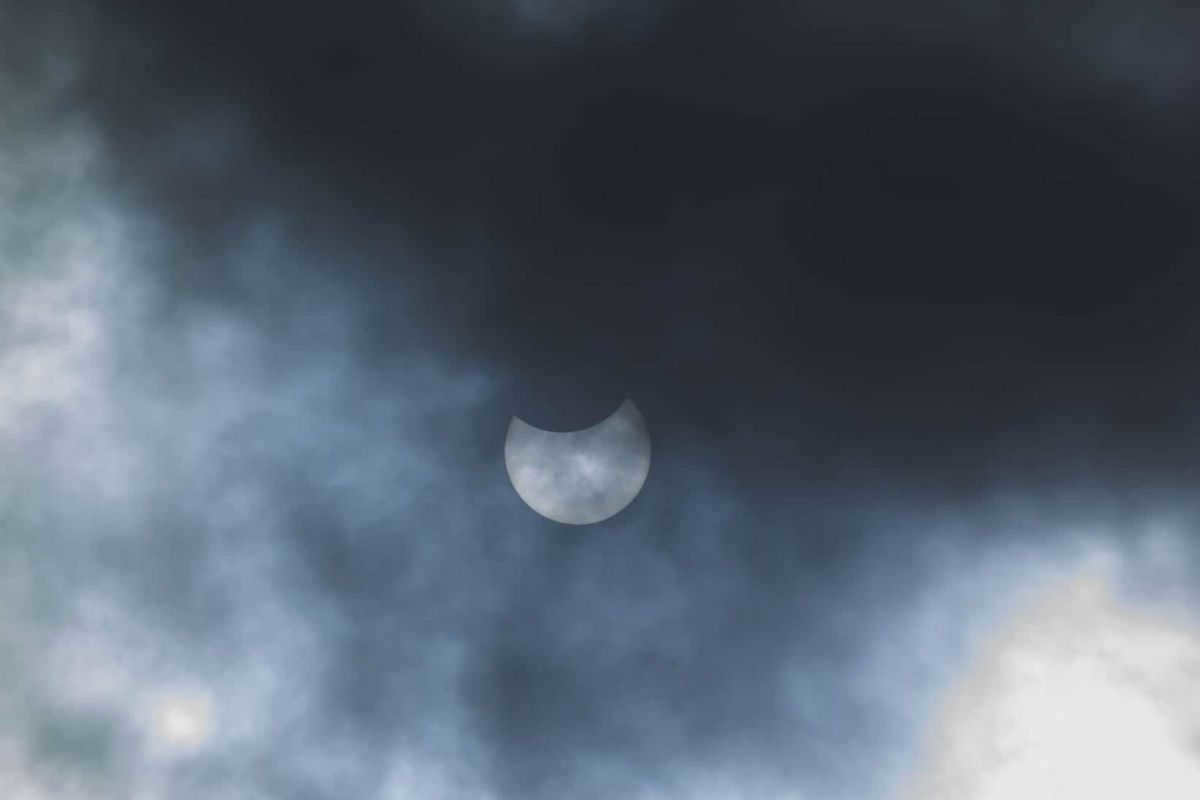
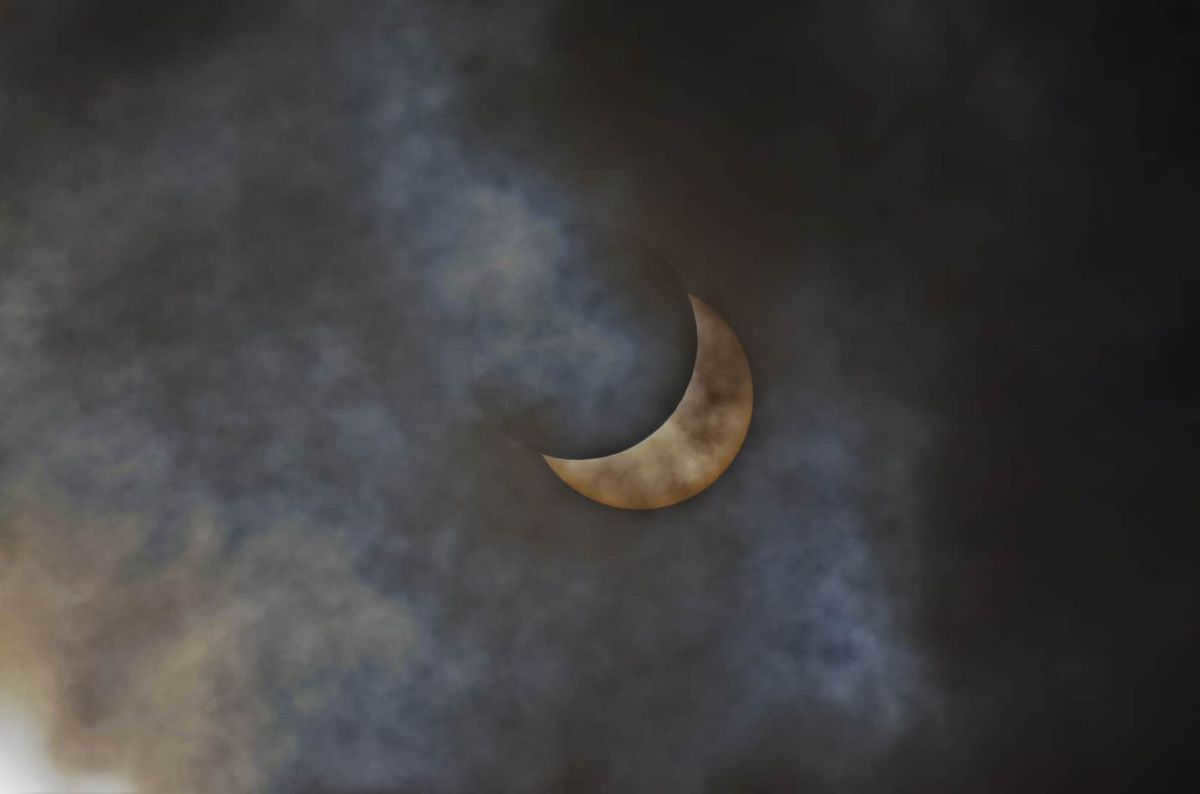
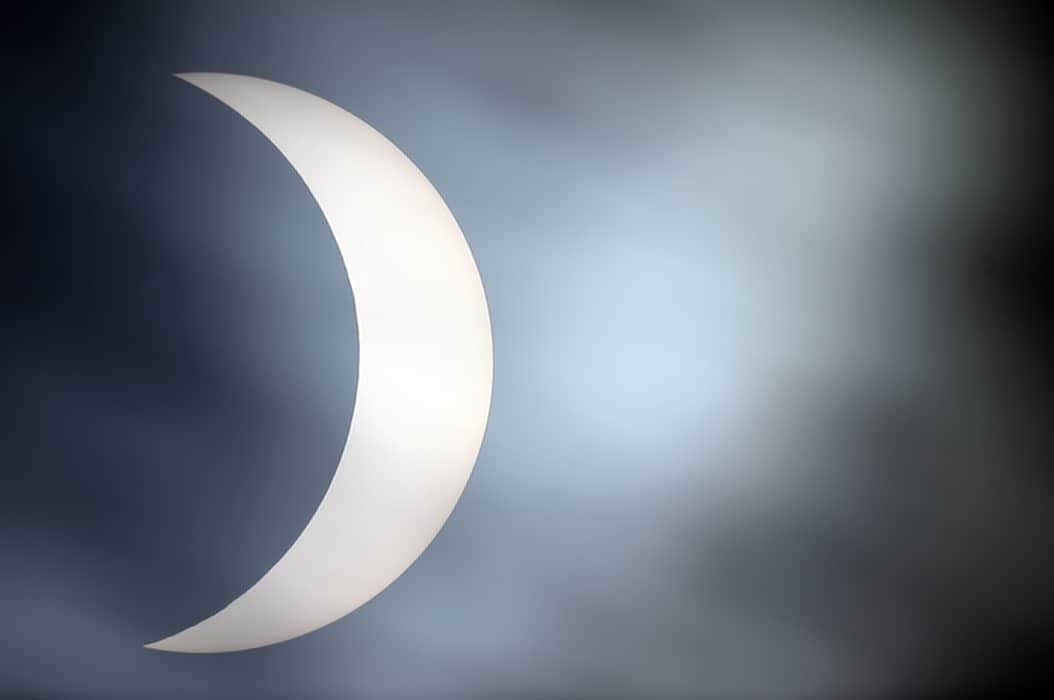
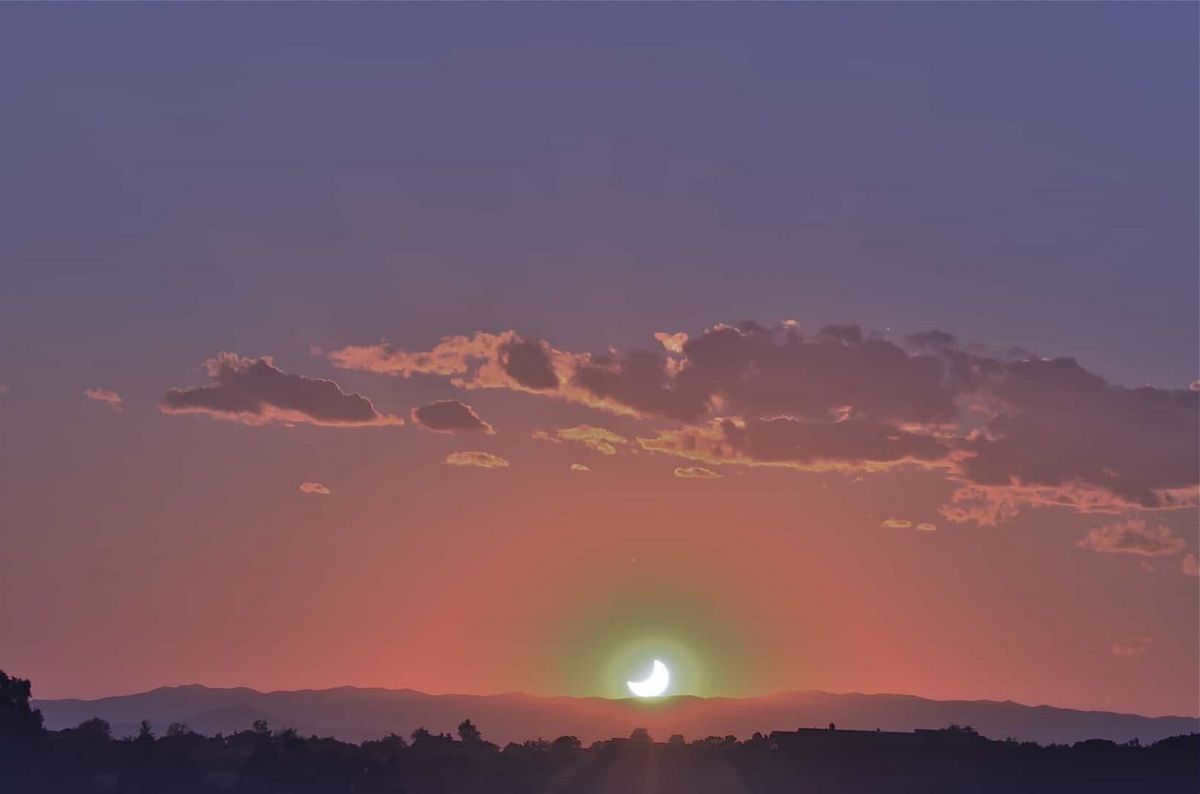
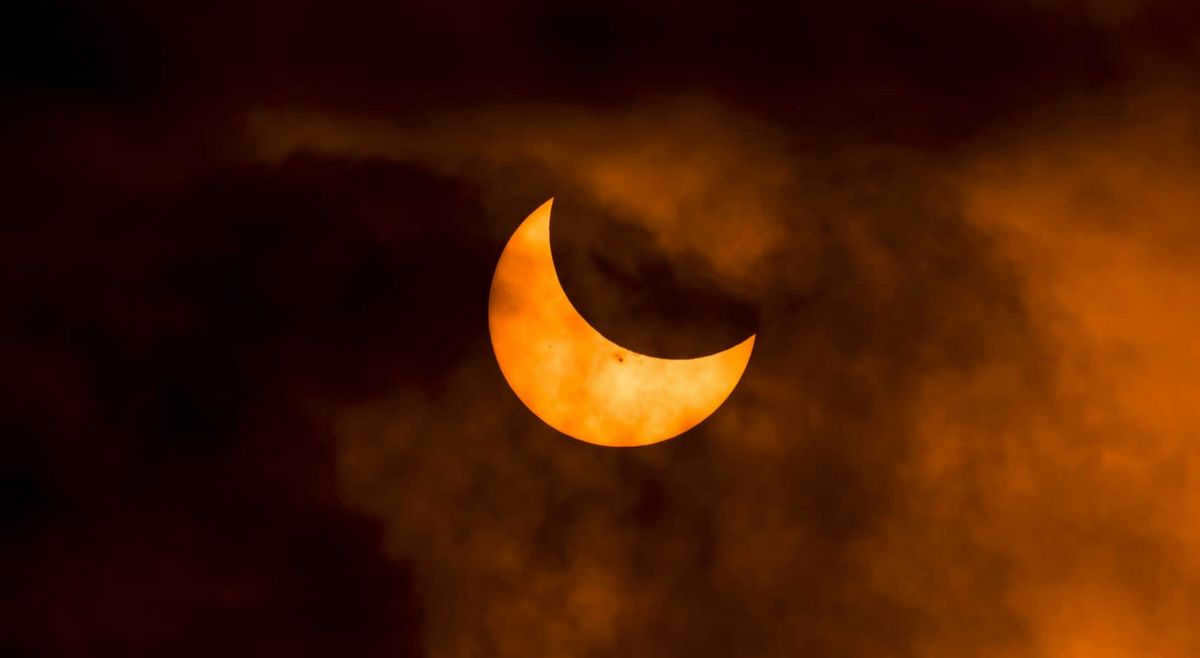
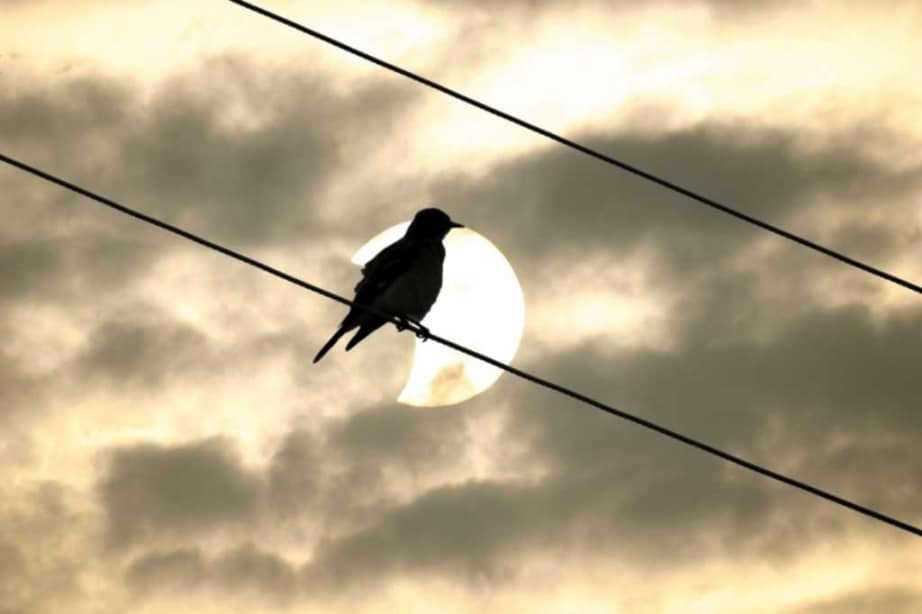
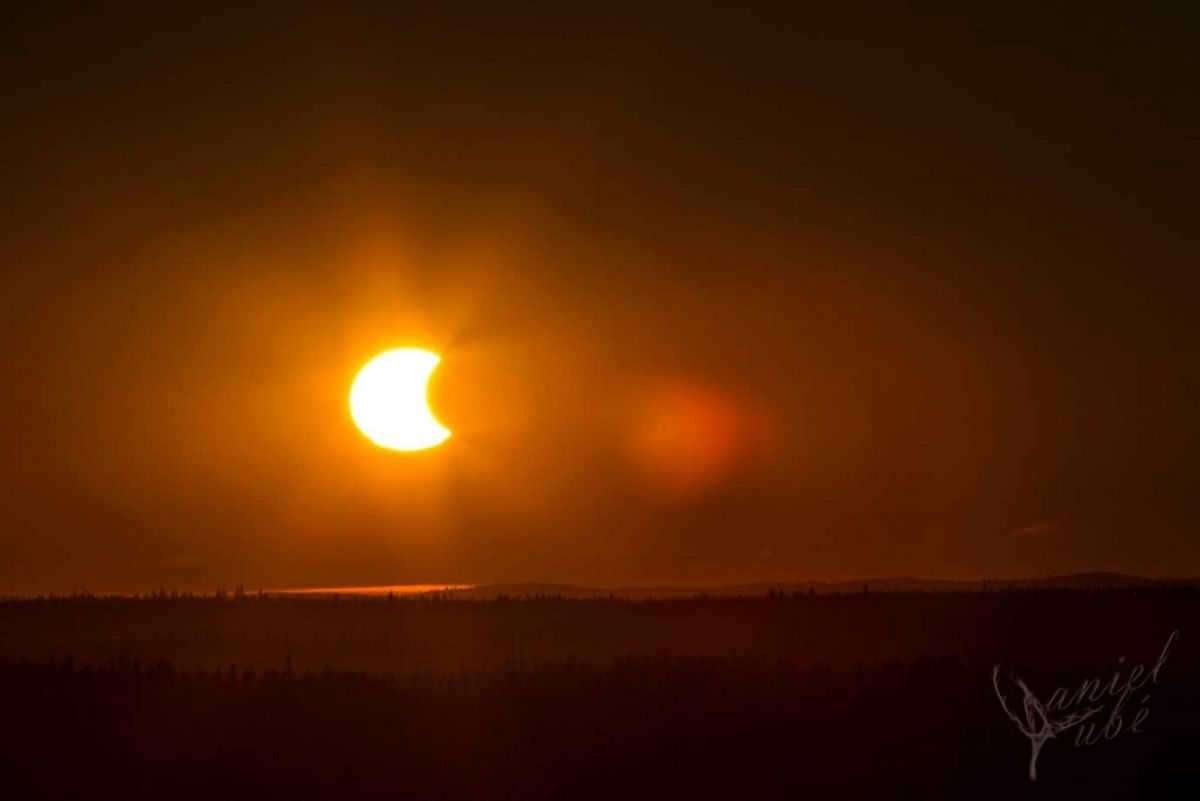
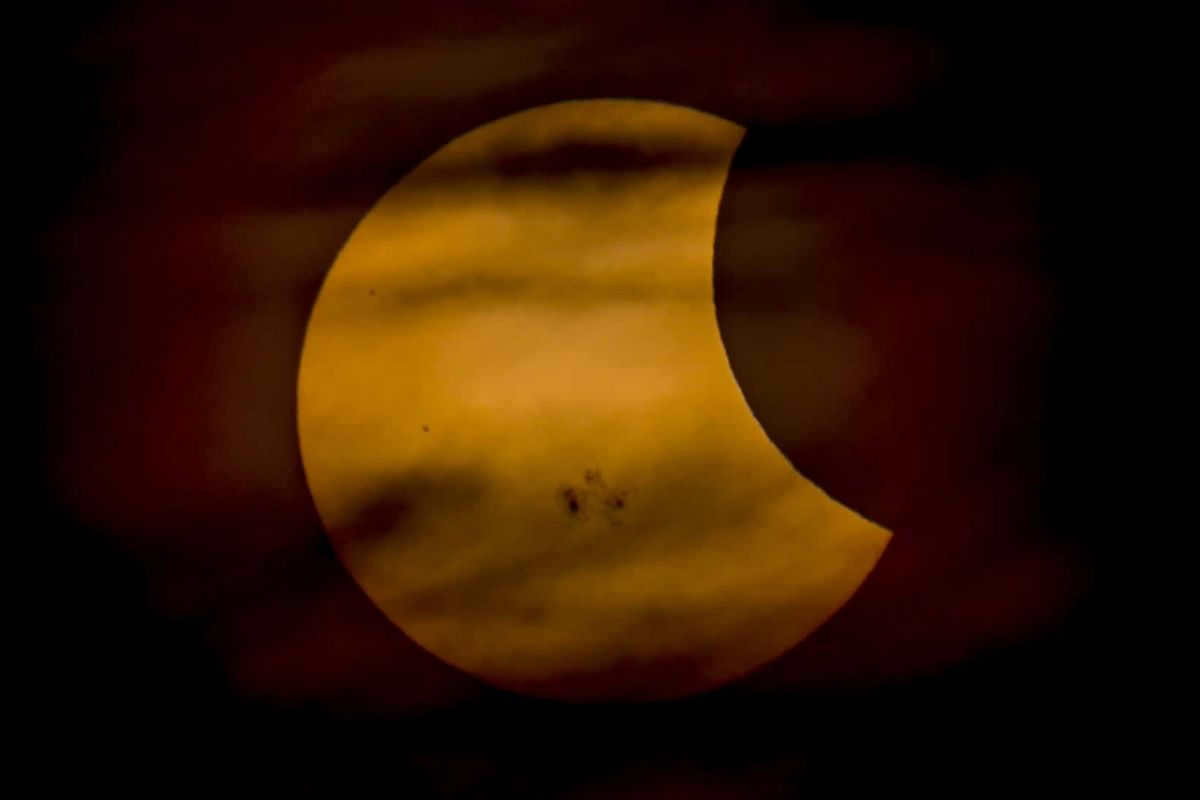
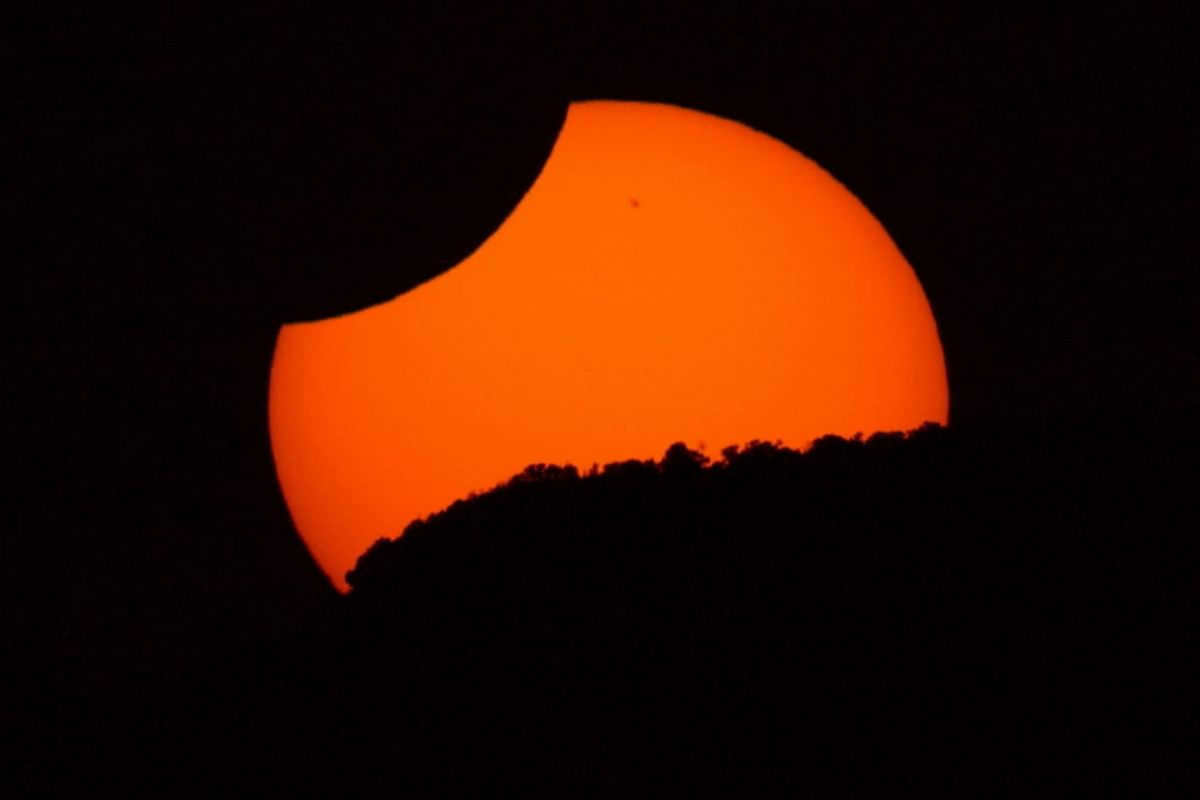
- Methods of observing the Sun
- Techniques for observing the Moon
- Exploring the Moon’s surface: 100 fascinating objects
- Observing Mercury and Venus
- Studying Mars through telescopes
- Guide to observing Jupiter
- Observing Saturn and its rings
- Exploring Uranus, Neptune, and Pluto
- Understanding solar eclipses
- Observing lunar eclipses
- Techniques for observing dark nebulae
- Exploring globular clusters in the night sky
- Introduction to double stars
- Discovering the beauty of the Polar Lights
- The mystery of silver clouds: discovery, observations, and properties
Here’s a not very smart joke: “You can look at the Sun twice in a lifetime through a telescope – with your right eye and your left eye”. It’s not really a safety precaution, but rather the opposite. The more ways you know to safely view the Sun through a telescope or the more times you’ve personally observed it, the more ridiculous the joke becomes. Simple technologies like solar filters or projecting it onto a screen make it completely safe to observe our Sun. And with more advanced technology and clever techniques, the man-made Parker Solar Probe will even be able to dive directly into the Sun in 2021 (and yes, the “flying at night” jokes have gotten a little worse as well). That’s what we’ll be discussing today.
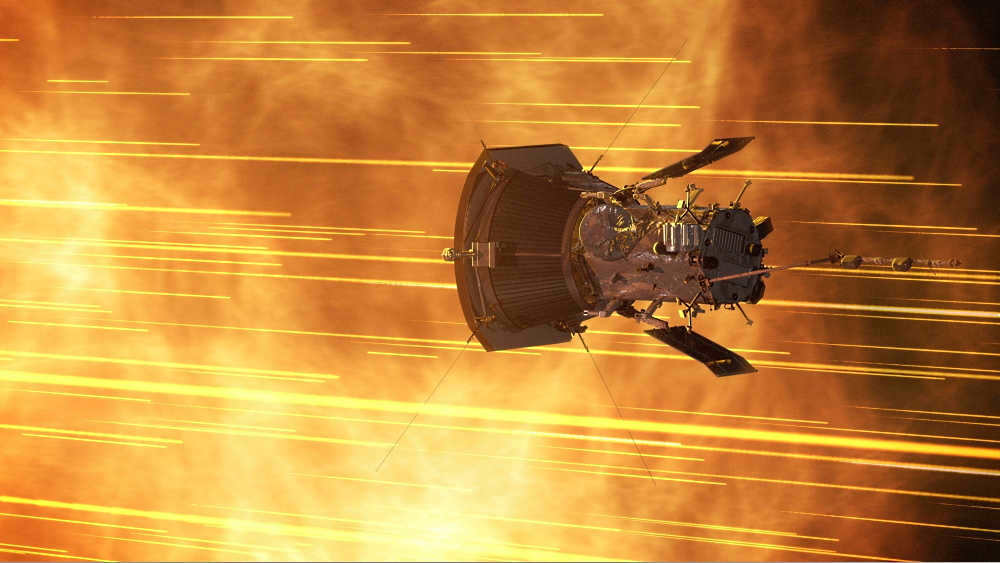
NASA illustration of Parker Solar Probe in close proximity to the Sun
For those who prefer visual content, there is also a video version available that includes a reconstruction of the gravitational maneuvers performed in the Orbiter simulator.
Fascinating Sun
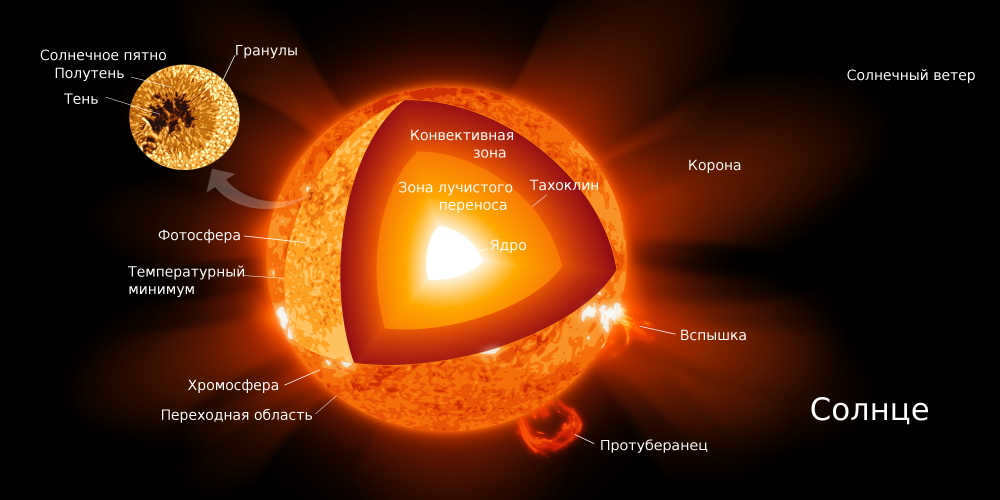
Observing the Sun: Exploring its fundamental phenomena and intricate composition, as depicted in the captivating image captured by Kelvinsong/Rubin16/Wikimedia Commons.
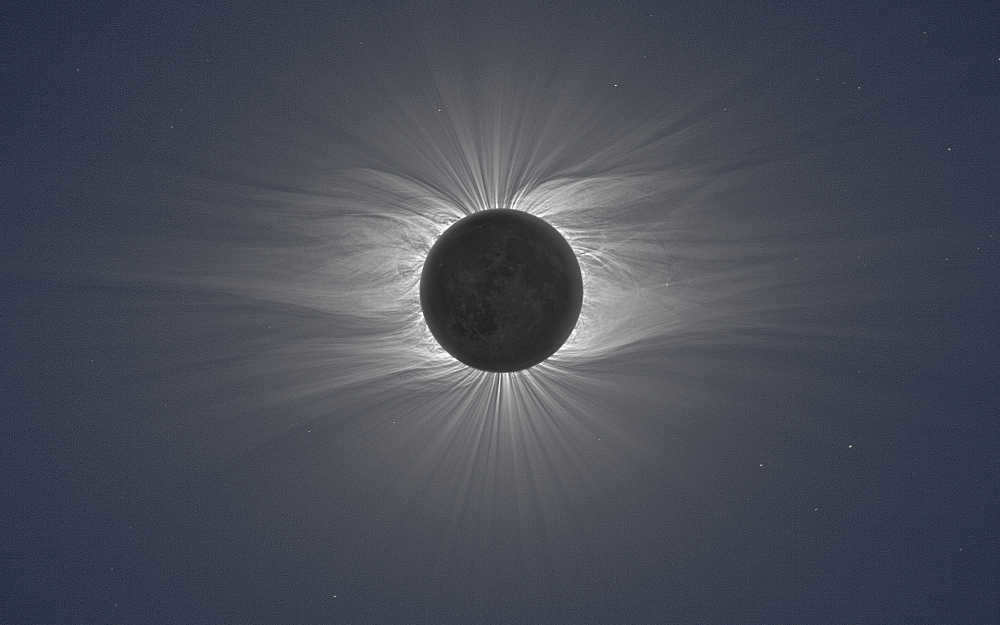
Solar eclipse, photo by Miloslav Druckmuller
The corona contains distinguishable loops created by closed magnetic field lines and streamers resembling the ancient Russian ostroverted helmet. These structures are commonly found over regions of heightened activity. In the X-ray spectrum, which necessitates observations from space, coronal holes are visible. These holes serve as the origin of the rapid solar wind. Additionally, if a Doppler radar is pointed at the Sun, it will reveal the presence of supergranules, which are massive in size, spanning tens of thousands of kilometers.
Flares occurring on the Sun and coronal mass ejections result in geomagnetic storms on Earth, which not only present themselves as stunning auroras. An incredibly strong geomagnetic storm in March of 1989 caused a complete blackout in the Canadian province of Quebec for a period of nine hours. To this day, mankind has not been able to accurately predict solar flares that will occur days or weeks in advance; currently, we can only make probabilistic assessments such as “there is a spot moving across the sun’s surface that could potentially be the source of a coronal mass ejection, with a 25% probability.” In recent times, there have been two major scientific mysteries related to the Sun, but one has been solved. The issue of the lack of solar neutrinos was resolved at the start of the 21st century. However, the question of why the temperature of the solar corona exceeds one million degrees while the temperature of the underlying photosphere is only 5500 °C, remains unanswered.
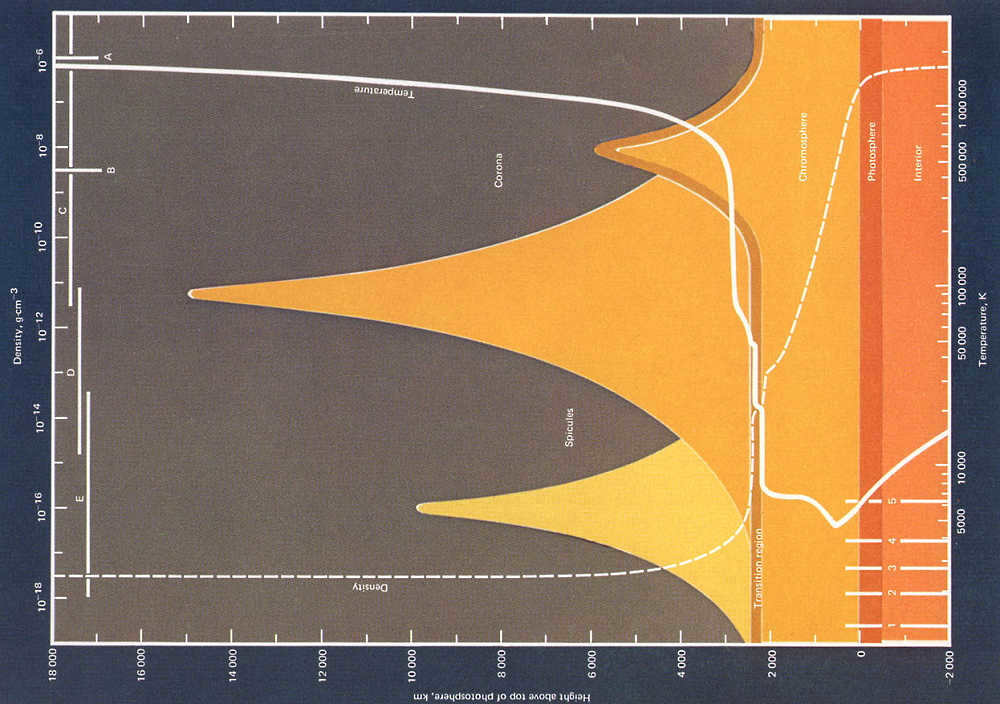
Density and temperature at various distances from the Sun based on data from NASA
A brief journey through time
In addition to the numerous solar observatories located worldwide (for example, residents and visitors of St. Petersburg can freely observe the now inactive Pulkovo radio telescope), the Sun has been studied from balloons, solar eclipses from 1965 to 1980 were observed from the NC-135 aircraft, and, of course, the beginning of the space age led to the emergence of heliophysical space missions.
The Soviet station Luna-1, launched on January 2, 1959, was the first spacecraft to directly record the solar wind. Prior to this, previous vehicles had only flown in low orbit. Luna-1, however, was able to reach the second space velocity and discovered a hot, fast-moving plasma in interplanetary space, which was named the solar wind. It was observed to be moving at a speed of 300-400 km/s and was extremely rarefied. On March 25, 1961, “Explorer 10” was launched and within a few hours of its active existence, it was able to record a shock wave from a solar flare. Over the following years, the number of heliophysical space missions exceeded sixty.
In 1995, the Solar and Heliospheric Observatory (SOHO) was launched into a halo orbit around the Lagrangian point L1, which is located one and a half million kilometers from Earth on the Earth-Sun line. This observatory is still functioning today and, in addition to its observations of the Sun in various wavelengths, has enabled several dozen enthusiasts to discover over four thousand comets near the Sun. Furthermore, SOHO serves as a valuable source of data on solar weather. ACE, WIND, and DSCOVR are also neighboring satellites that focus on studying the Sun.
An animation based on SOHO photos depicting the current state of the solar corona.
Orbits of the STEREO vehicles in relation to the stationary Sun and Earth, animated by Phoenix7777/Wikimedia Commons
Gravity maneuver
To understand the unique characteristics of the flight of the aforementioned spacecraft, it is essential to discuss the concept of gravity maneuver. The curvature of space-time, also known as gravity, can be effectively demonstrated using a stretched sheet and balls. If we place a weight in the center of the stretched sheet, it will cause a localized depression in the fabric. Consequently, if a balloon is launched and rolls through this depression, its trajectory will be altered.
View of the stretched sheet from an overhead perspective, source
Another simple analogy for the gravity maneuver is imagining that you have a friend who owns a convertible. You stand on the side of the road and start throwing balls at him (let’s keep this as a mental experiment, because real convertibles are not cheap). If you throw a ball while he is moving towards you, when he throws it back, it will come at you with greater speed. Conversely, if you throw it back at him, it will come at a slower speed.
In practice, the gravitational maneuver allows you to alter the orbit parameters of a spacecraft by passing close to a massive object, such as a planet. Depending on the trajectory, you can either accelerate, decelerate, or change the orbital plane without expending additional fuel. For many years, space missions have been planned in a way that it is more advantageous to extend the duration of the journey and fly past a planet, rather than having to launch the spacecraft on a heavier and therefore more expensive rocket.
The adventure through time continues
An extraordinary mission in terms of ballistics, the “Ulysses” was launched on October 6, 1990. On February 8, 1992, the spacecraft reached Jupiter and, using its own propulsion, altered its orbit by 80 degrees, transitioning to an almost polar orbit in relation to the plane of the solar system. The pericenter, the point of closest approach to the Sun, was positioned beyond the Earth’s orbit, while the apocenter, the farthest point, was in the vicinity of Jupiter. The new orbital period became six years. “Ulysses” passed over the Sun’s polar regions in 1994/95 and made two more passes during subsequent rotations. The last communication session occurred on June 30, 2009.
Animation of Ulysses’ orbit by Phoenix7777/Wikimedia Commons
Released on February 10, 2020, Solar Orbiter is likely to be eclipsed by the Parker Solar Probe’s notoriety – it will only approach the Sun as closely as 0.3 astronomical units. However, these missions share a commonality in their repeated flyby of Venus. Additionally, Solar Orbiter is connected to the “Ulysses” mission in its transition to an orbit of progressively higher inclination, enabling it to observe the polar regions as well.
Solar Probe
With the scientific community’s fascination with the Sun, it comes as no surprise that there have been discussions about sending a probe to study the Sun within Mercury’s orbit since as early as 1958. The Fields and Particles Panel of the U.S. National Academy of Sciences began contemplating the potential spacecraft that could be launched for this purpose. However, due to its complexity, the mission remained in the realm of ideas and projects for several decades. In the late 20th and early 21st centuries, a project with a trajectory similar to that of the “Ulysses” was considered – the spacecraft would have initially traveled to Jupiter and, through gravitational maneuvers, moved into an orbit with a pericenter very close to the Sun.
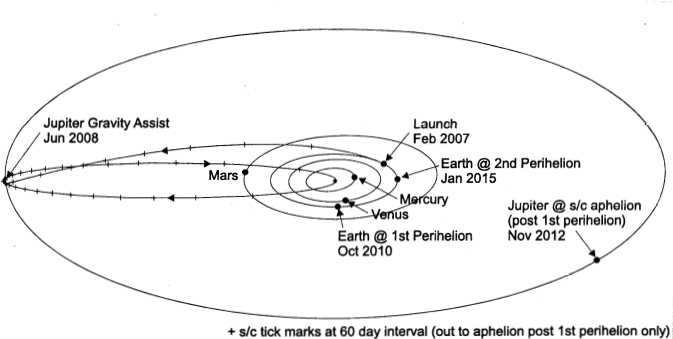
Proposed trajectory of the device, source
However, this trajectory presented significant technical challenges – the device had to be engineered to withstand the extreme cold of the outer solar system as well as the intense heat of the inner solar system. The energy emitted by the Sun follows the inverse square law, meaning that at a distance equivalent to the Earth’s orbit it is 1, but at Jupiter it is only 1/25, and near the Sun it is tens or even hundreds of times greater. In order to prevent the probe from freezing at Jupiter, it was necessary to provide it with three radioisotope heat and power sources, and to prevent it from melting near the Sun, a heat shield had to be included in its design. This design was impractical and exceedingly costly.

Variations of the equipment layout
In the 2010s, there was a change in the concept. Instead of using the convenient Jupiter for gravitational maneuvers, it was decided to opt for the much lighter Venus, but in greater quantities. This decision solved multiple problems at once – the equipment only needed to be designed for the thermal balance within the inner solar system, each orbit took less time, allowing for the collection of more scientific data, and the technical requirements for communication with the equipment at distances to Jupiter were no longer necessary. The mission was named Solar Probe Plus.
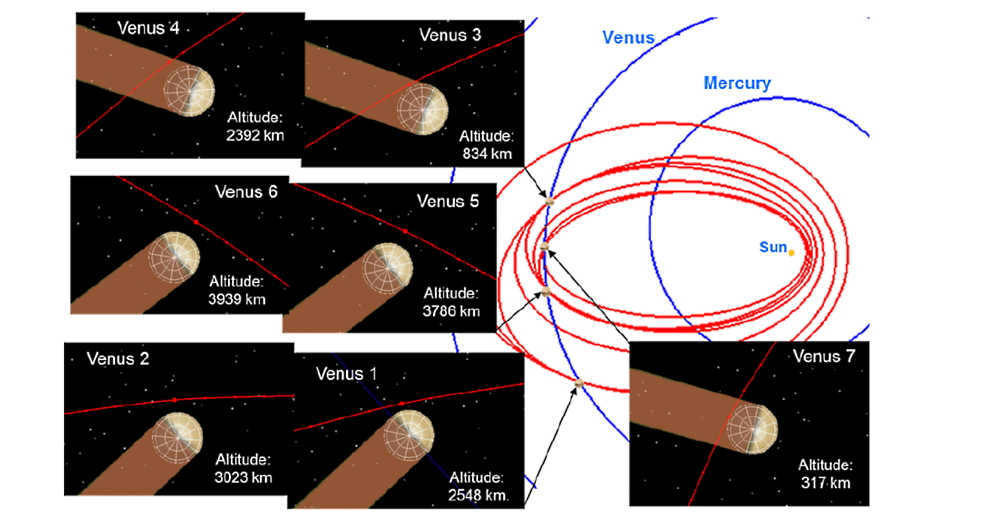
Plan of maneuvers near Venus, source
The probe’s trajectory began from Earth and the initial plan was for it to pass by Venus and decelerate. During the first leg of the journey, the spacecraft would approach the Sun at a distance twice as close as Mercury does at its pericenter, reaching a proximity of 24.8 million kilometers. At the same point in Venus’ orbit, when the planet completed two revolutions and the probe completed three, the second maneuver occurred, bringing the pericenter down to 19.4 million kilometers. The third, fourth, fifth, and sixth maneuvers also occurred at this same point in the orbit. Only the final, seventh maneuver did not have a corresponding pair. As a result, the spacecraft ended up in close proximity to the Sun, at a mere distance of 6.9 million kilometers. This was the chosen course of action to execute the mission.
Renamed and Revitalized: New Identity and Cutting-Edge Technologies
In a remarkable tribute to the exceptional achievements of Eugene Parker, a distinguished astronomer and plasma physics expert, the apparatus was officially renamed in 2017. Parker’s groundbreaking work accurately predicted numerous characteristics of the solar wind, solidifying his status as a true visionary in the field. This historic decision not only honors Parker’s invaluable contributions but also signifies a new era of advancements and breakthroughs, as the apparatus embraces cutting-edge technologies that will further revolutionize our understanding of the cosmos.
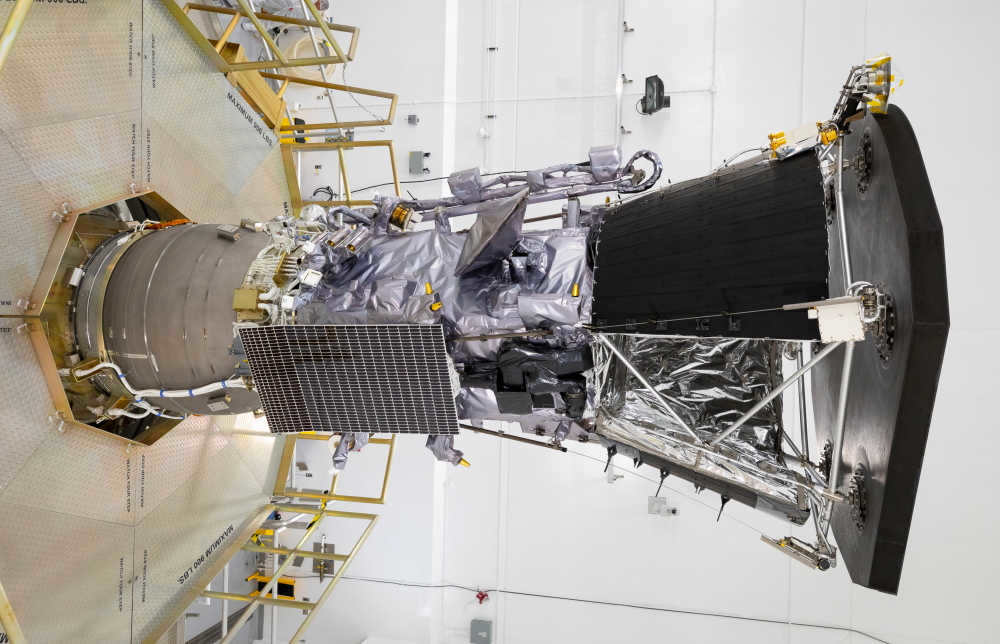
The Parker Solar Probe is getting ready for launch, as shown in this NASA photo.
The photo reveals the Parker Solar Probe already mounted on the Star-48BV upper stage, which can be seen as a barrel-shaped structure with a different color on the left side.
In order to withstand the intense heat and energy of the Sun, the Parker Solar Probe incorporated special technological advancements. The most significant one is the heat shield, which provides shade for almost all the other components of the spacecraft.
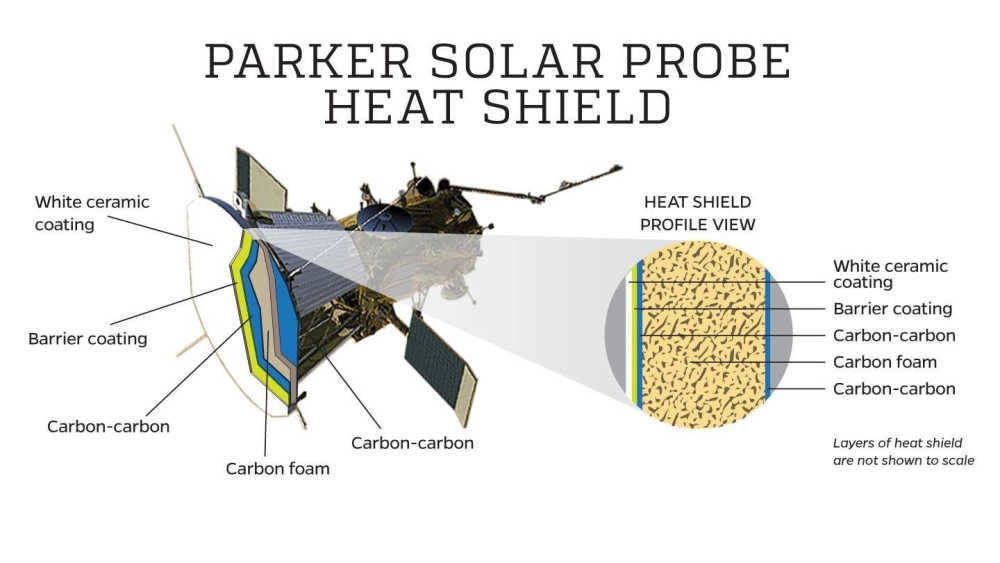
Illustration of a heat shield section by NASA
The heat shield is composed of multiple layers and measures 2.4 meters in diameter and 11.5 centimeters in thickness. It has a weight of 72 kilograms. The shield is constructed with a white ceramic outer layer, followed by a protective layer and two layers of reinforced carbon-carbon composite material with a layer of carbon foam in between. Carbon foam is a novel thermal insulation material with low density. During the shield’s production, engineering challenges had to be overcome, such as ensuring that no significant amount of oxygen remained in the foam to prevent charring under operational conditions. The ceramic outer surface can reach temperatures of approximately 1600 degrees Celsius at maximum proximity to the sun, but this heat is not transferred to the inner surface where the spacecraft’s frame is attached.
In an initial iteration of the vehicle, there was a proposal to incorporate two sets of solar panels. One set would extend during the maximum approach phase, while the other set would remain stationary. However, the final design opted for a different approach by using two parts for the solar panels. The outer part is mounted at a different angle and utilizes active cooling. Given that the vehicle operates in the inner solar system, ordinary water serves as the coolant. A heated tank stores 3.7 liters of deionized water, which provides cooling for the external portion of the solar panels. This cooling system operates within a temperature range of 10 to 150 degrees, with a maximum limit of 200 degrees. Importantly, the water does not boil until it reaches 210 degrees. To dissipate heat, heat radiators are located on a conical transition part situated just behind the heat shield.
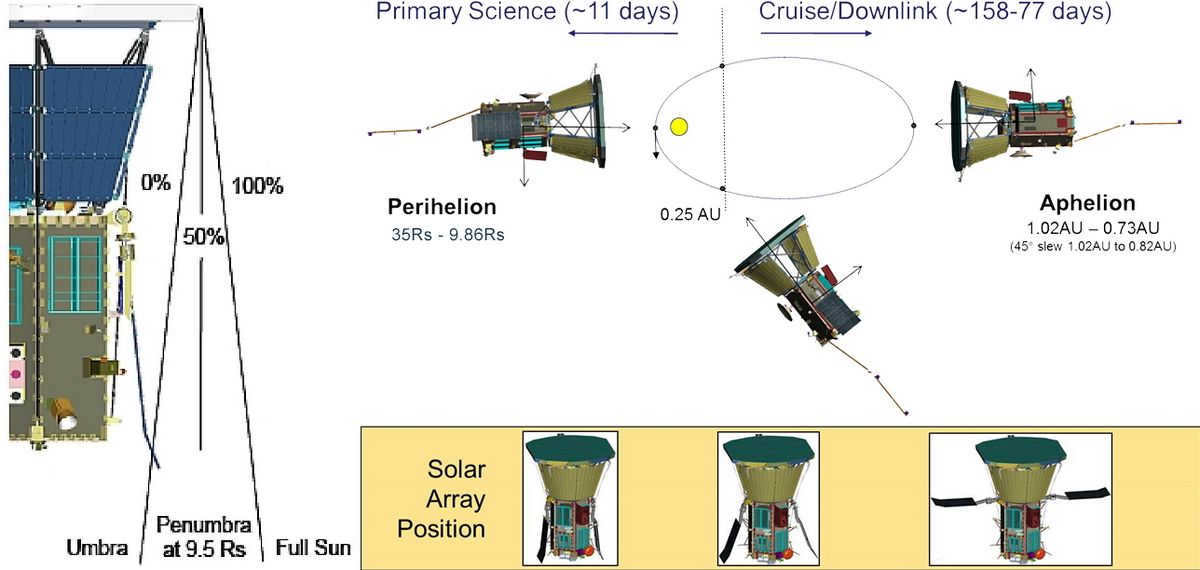
The positioning of the solar panels, source
When the spacecraft is in the pericenter area, the solar panels are completely folded in and only the edge is exposed to the penumbra from the shield. As the spacecraft moves towards the apocenter region, the solar panels gradually unfold and become fully exposed. In the area between the pericenter and apocenter, the solar panels occupy a position that is somewhere in between fully retracted and fully exposed.
Communication with the spacecraft is impossible near the pericenter, as it operates autonomously during this time. Its main objective is to maintain the correct position with the shield facing the Sun and gather scientific data. Two star sensors are used to determine the spacecraft’s position in space, but they cannot be used near the pericenter. To overcome this limitation, special sensors called limbo sensors are installed, which detect the shift of the shadow from the shield. The Parker Solar Probe achieves rotation through the use of flywheels. Since the probe needs to navigate through a very narrow “corridor,” it only activates its engines for minor corrections. Therefore, it does not require a propulsion system with a large range of characteristic speed. The Parker Solar Probe is equipped with 12 single-component hydrazine-fueled engines, each providing a thrust of 440 grams. Another unique aspect of the mission is that trajectory corrections are performed either when the shield is facing the Sun or near the apocenter of the orbit. To prevent overheating during these maneuvers, certain components of the probe are equipped with louvers.
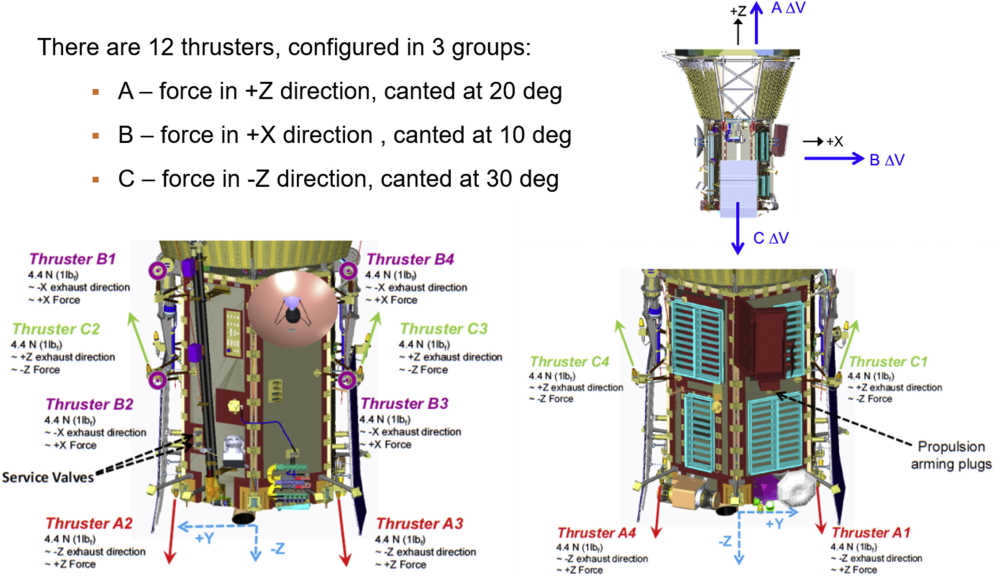
The motors in the picture are arranged in an unsymmetrical way, with the turquoise rectangles acting as louvers. This image was sourced from a reliable scientific equipment.
Advanced scientific instruments
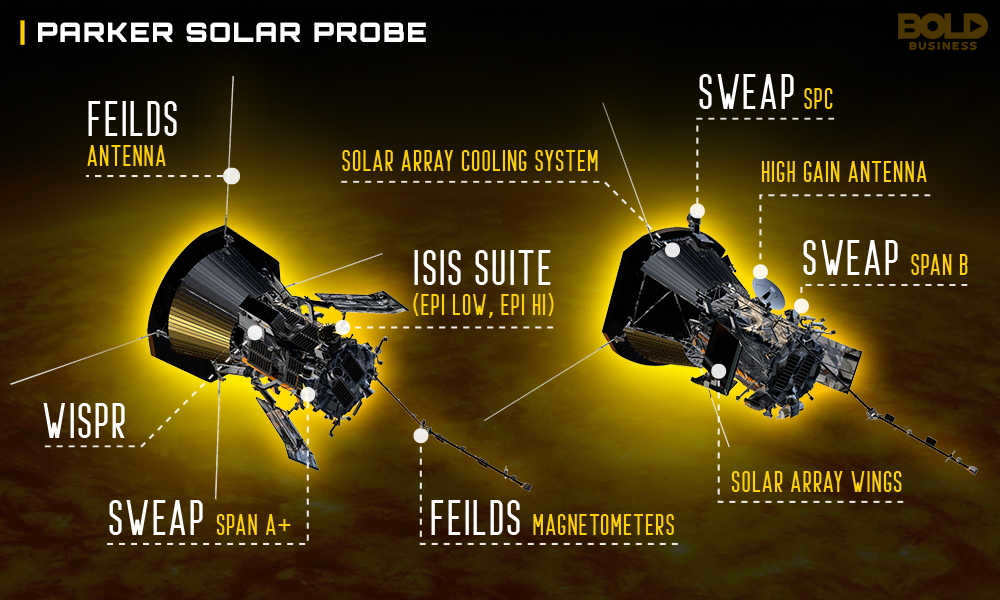
Arrangement of scientific instruments on the spacecraft, image by Bold Business
The scientific instruments on the spacecraft are specifically designed to observe and analyze the Sun, including its magnetic fields, solar wind streams, and particles. These instruments, which are not protected by a shield, have been specially adapted to function in close proximity to the Sun.
The FIELDS (Electromagnetic Fields Investigation) instrument collects data on electric and magnetic fields, radio waves, and plasma parameters. To achieve this, there are five voltage sensors and three magnetometers mounted on four sideways-facing antennas and a mast positioned in the shade. As the side antennas are exposed to sunlight, they are made from a C-103 alloy with niobium, and the base is covered with additional heat shielding.

FIELDS instrument configuration and antenna design, origin
The sensors of high-energy (EPI-Hi) and low-energy (EPI-Lo) particles are part of the IS☉IS (Integrated Science Investigation of the Sun) instrument. The design of the EPI-Lo is particularly fascinating. It consists of eight sectors, each with ten guide holes. When an ion is trapped inside, it is detected by the first detector, while an electron is detected by the second detector. The position of the detection allows for the determination of the arrival direction. Consequently, this instrument enables the measurement of particle intensity in various directions across a complete hemisphere.
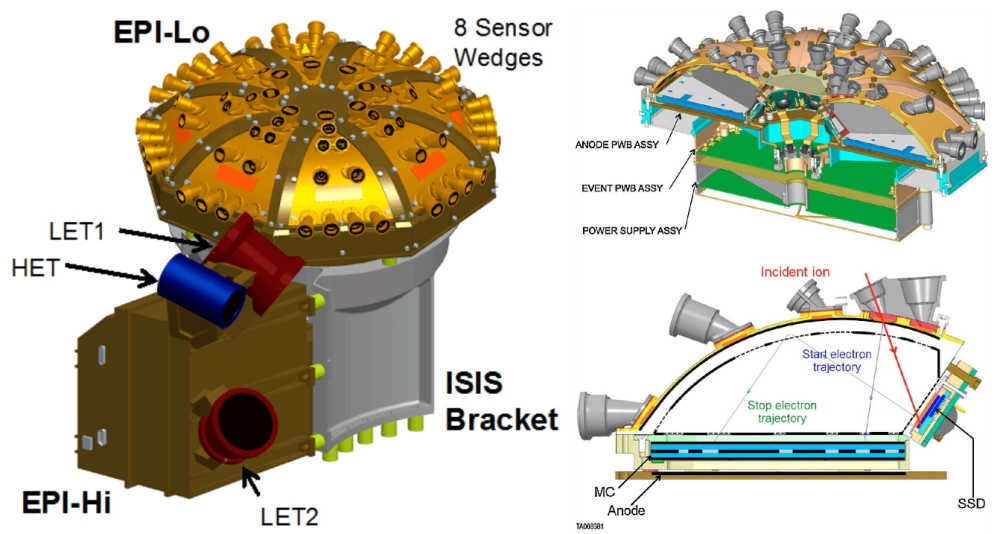
IS☉IS, source
SWEAP (Solar Wind Electrons Alphas and Protons, Solar Wind Electrons, Alpha Particles and Protons) consists of three sensors that record the flow of solar wind: protons, electrons, and alpha particles (helium atom nuclei). The most intriguing instrument in the SPC is the Faraday cylinder, which is located on the heat shield and is exposed to sunlight. During the closest approach to the Sun, the outer cover’s temperature can reach over 1600 degrees Celsius, so it was constructed using tungsten. The sensor itself is made up of niobium lobes with sapphire insulation.
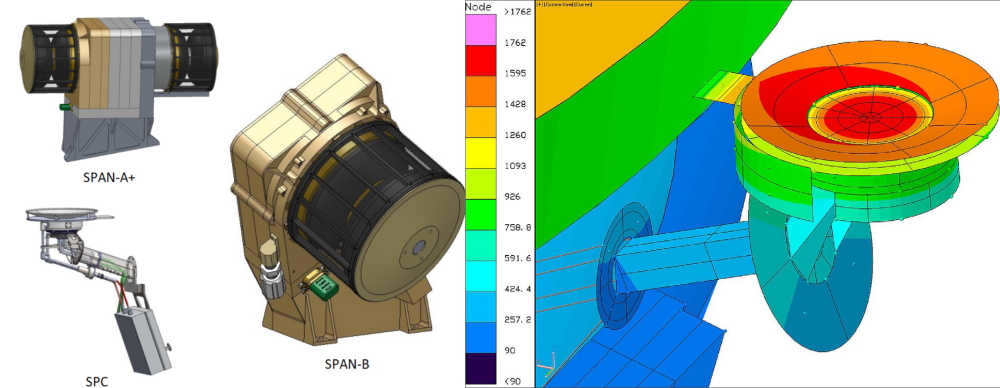
SWEAP and temperature distribution at the SPC pericenter, source
The WISPR instrument, equipped with two cameras at angles of 13°/53° and 50°/108°, is capable of functioning as a coronograph and capturing images of solar wind streams. Despite its cameras facing away from the Sun, the instrument’s close proximity to the star allows for this unique capability.
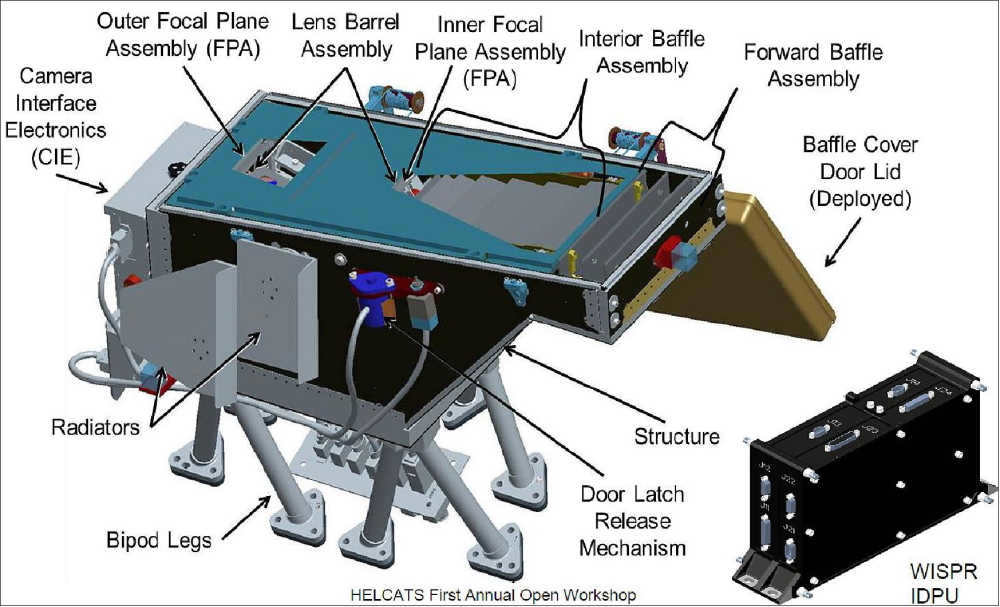
WISPR design, source
Launch and flight
The Parker Solar Probe was successfully launched on August 12, 2018, at 07:31 UTC. The distinguished guest at the launch was Eugene Parker, who, at the time, was 91 years old (and is still alive, by the way). The Delta IV Heavy, one of the most powerful rockets in the world, was used for the launch. Capable of launching 29 tons into low orbit, it carried the Parker Solar Probe, which has a mass of only 685 kilograms. To ensure a successful trajectory, a heavy Star-48BV upper stage was installed on the rocket. The launch was strategically planned shortly before dawn in order to achieve the desired path: a nighttime launch to reach the outer solar system and a daytime launch to travel to the inner solar system. This approach takes advantage of the Earth’s orbital speed, allowing the probe to subtract it from its own velocity.
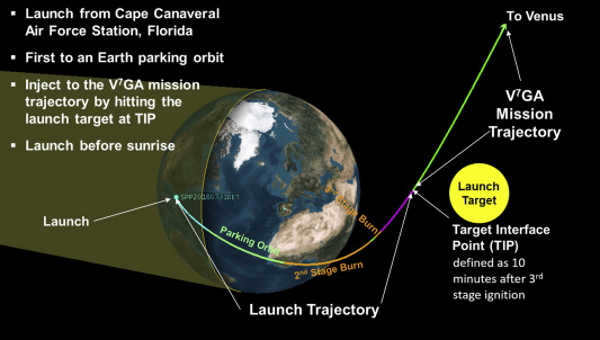
Origin of the Parker probe’s departure path
By February 2022, the Parker Solar Probe had successfully completed five gravitational maneuvers near Venus. The next maneuver, which will be the sixth and penultimate, is scheduled for August 2023. The device reached its tenth pericenter on November 21, 2021, and the eleventh pericenter is expected on February 25, 2022. During the tenth to sixteenth pericenter, the probe will approach the Sun to a distance of 9.2 million kilometers (8.5 kilometers above the surface). According to Kepler’s second law, the speed of the satellite increases as the elliptical orbit becomes more stretched near the pericenter. As a result, the Parker Solar Probe has set a new record for absolute speed, currently accelerating to 160 kilometers per second near the Sun. The upcoming gravitational maneuvers are expected to further increase its speed.
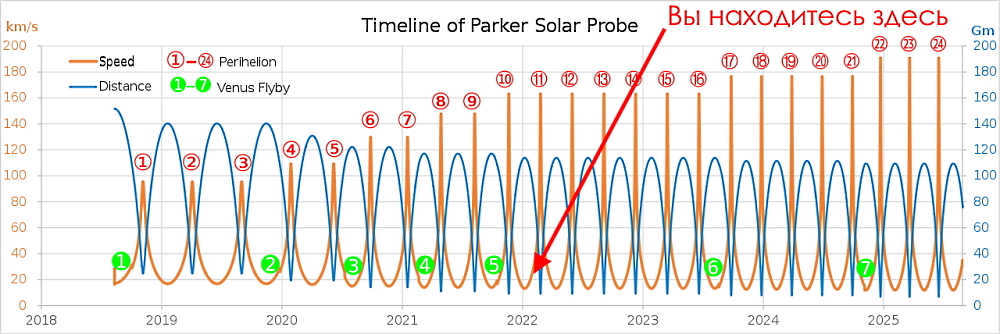
Image credit: Phoenix7777/Wikimedia Commons
Preliminary findings
The most significant outcome of the mission was the daring descent into the Sun’s atmosphere. Upon analyzing the data gathered during the eighth pericenter on April 28, 2021, it was discovered that the probe delved beneath the Alven’s surface on three separate occasions. So, what exactly is Alven? Alven magnetohydrodynamic waves propagate throughout the solar corona. The critical Alven surface, which marks the boundary between the solar atmosphere and the unrestricted flow of the solar wind, is defined as the region where the linear velocity of matter in the corona surpasses the propagation velocity of Alven waves. At present, the solar wind is no longer considered part of the Sun’s atmosphere, as the boundary between the solar system and interstellar plasma is deemed the point where the interstellar plasma becomes stronger than the solar wind. Through direct measurements conducted by the Parker Solar Probe, it has been determined that Alven’s surface is situated, on average, approximately 13.6 million kilometers from the star’s center (equivalent to 18.8 solar radii). The boundary itself is irregular and its altitude fluctuates over time.
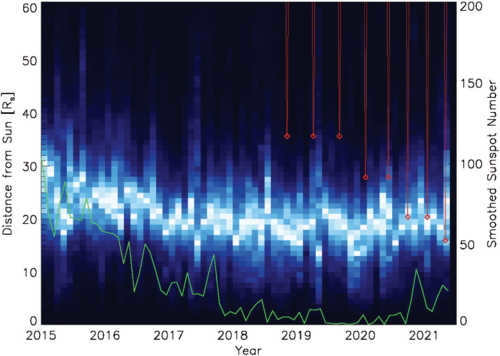
The light represents the estimated position of Alven’s surface, while the green line indicates the average number of sunspots. The red lines depict the trajectory of the Parker Solar Probe. Source
In addition to these discoveries, the probe has also encountered various other phenomena. One of the earliest observations was the identification of a zone devoid of dust. Within a distance of less than 5.6 million km, dust simply gets vaporized.
The Ulysses probe has detected magnetic field structures in the subpolar regions of the Sun that resemble an S-shape. Initially, scientists believed that these occurrences were rare and only found in the circumpolar regions. However, the Parker probe has unveiled a multitude of magnetic field switchbacks.
NASA animation showcasing magnetic field switchbacks
These findings suggest that switchbacks are closely linked to supergranules.
The spacecraft also passed through coronal streamers and experienced a calmer environment inside compared to the outside. The probe documented turbulent solar wind and captured flares that were too faint to be observed from Earth. Additionally, it encountered high-speed cosmic dust particles, resulting in interference in WISPR photographs and providing additional scientific data.
Images taken by WISPR’s cameras
The primary mission of the spacecraft is set to continue until the end of 2025, with the possibility of an extension. The spacecraft’s ability to maintain its position in space is crucial, as any failure in the flywheels or control system could cause the Parker Solar Probe to become a molten mass orbiting the Sun indefinitely. Hopefully, this scenario will not occur anytime soon, and we will obtain a wealth of intriguing insights into the workings of the Sun.

There are two methods for safely observing the Sun: directly viewing it with a telescope equipped with the proper filter, or projecting an image of the Sun onto a piece of paper. To view the Sun directly, place the filter on the front of the telescope. If any bright spots are visible through the filter, they should be covered with opaque paint.
Is it safe to use a lunar filter to look at the Sun?
A lunar filter reduces the brightness of the Sun while preserving its details. Similar to a solar filter, it significantly reduces the Sun’s brightness. It is important to never look at the Sun through a telescope without the appropriate filter. While most lunar filters are suitable, some individuals, including myself, prefer to use a polarizing filter.
Is it safe to use telescope solar filters? Solar filters typically consist of materials like aluminum-coated mylar or coated glass, but it is advisable to seek advice from a trusted retailer. It is crucial to exercise caution while using these filters as they are positioned at the focal point where the sun’s immense power is concentrated. If the filter were to break, it could potentially allow in intense sunlight that can cause temporary or permanent blindness. Additionally, there are telescopes specifically designed for viewing the sun.
What are the consequences of observing the sun through a telescope with a filter?
Recommended reading:
To observe the Sun, it is recommended to use a telescope or binoculars with a proper filter. With the help of a filter, you can capture amazing details, such as the granulation – small cells formed due to the gas boiling on the surface of the Sun.
What type of filter is necessary for observing the Sun?
If you have a telescope and want to directly observe the Sun through its eyepiece, it is crucial to use a full-aperture solar filter. This filter should be mounted on the front of the instrument. It is extremely dangerous to look directly into the eyepiece without proper protection, as it can cause permanent eye damage.
What is the technique for capturing an image of the Sun using a telescope? In order to capture an afocal photograph, one must first adjust the focuser of the telescope to obtain a clear visual image of the Sun through the eyepiece. Then, the camera is brought up to the eyepiece, and the camera focus is adjusted until a clear image is seen in the viewfinder or on the screen. At this point, the photograph can be taken.
What are the safe methods for observing the Sun?
There are two safe methods for observing the Sun: using a telescope with an appropriate filter on the front, or projecting an image of the Sun onto a piece of paper. These methods protect your eyes from both visible and invisible radiation, as well as the telescope from heat.
Is it safe to photograph the Sun?
Photographing the Sun can be done safely if you take proper precautions. These techniques can be used to capture the transit of Mercury on November 11. While astrophotography typically doesn’t involve photographing the Sun, it can still be a fascinating subject to explore.
What are the techniques for focusing on the Sun?
To achieve a sharp focus on the Sun, you can utilize the magnification options such as ×5 or ×10 in the live view. It is recommended to have a camera shutter release that connects to the camera body, as wireless models might not function properly under full sunlight conditions.
How can I adjust the focus on my telescope to observe the Sun?
If you want to have a quick initial observation of the Sun using this method, place a white card or paper a few feet behind the eyepiece of a tripod-mounted telescope or binoculars. Ensure that the card is shaded from direct sunlight. Adjust the focus until the edge of the Sun appears the sharpest.
What are the risks of observing the Sun through a telescope? It is crucial to understand that observing the Sun through an unfiltered camera, telescope, or binoculars is highly discouraged, even if you are wearing eclipse glasses. Van Gelder emphasizes that these devices concentrate the sun’s rays to a greater extent than our naked eyes, posing a significant danger of severe eye damage.
What is the meaning of sunspotting?
Sunspotting refers to the appearance of flat brown spots on the skin that have been exposed to the sun’s rays. These spots are also known as “liver spots,” although they are unrelated to the liver. It is important to note that sunspots are harmless.
How can one eliminate blotchy skin?
To address blotchy skin, it is recommended to incorporate a day and night cream into your skincare routine, such as a product from the Q10 range. Additionally, maintaining proper hydration by drinking an adequate amount of water throughout the day is crucial. After exfoliating to remove impurities and dead skin cells, using a lightweight cream can help restore hydration and counteract any dryness caused by essential oils.
What causes patchy tanning? The uneven increase in melanocyte cells, which produce melanin responsible for skin tanning, is often the culprit. This can lead to the formation of dark and light patches on the skin. To prevent this, it is crucial to limit sun exposure as much as possible.
Why is it dangerous to observe the sun directly through a telescope without filters?
It is crucial to understand that it is never safe to observe the sun through an unfiltered camera, telescope, or binoculars, even if you are wearing eclipse glasses. According to Van Gelder, these devices concentrate the sun’s rays more intensely than your eyes, which can result in severe eye injuries.
How can we observe the sun safely?
The only secure method to directly observe the Sun through your telescope while looking through the eyepiece is by attaching a solar filter to the large front (objective) lens. If your telescope has a finder, make sure to cover it with a filter or a lens cap to prevent any damage.
Is it possible for me to direct my telescope towards the Sun? Observing the Sun through a telescope offers a breathtaking view of a vibrant, ever-changing celestial body. However, it is important to note that the Sun poses a significant risk to the observer’s safety. Without appropriate precautions, such as protective eyewear, observing the Sun through a telescope or binoculars can lead to severe damage to the retina, potentially resulting in permanent visual impairment.
What happens if you direct a telescope towards the Sun?
According to Mark Thompson, when a telescope is pointed at the Sun, all the energy from the Sun is concentrated on the eye. This can result in severe damage, causing a burned hole in the cornea (the outer protective layer of the eye) and the lens (which, along with the cornea, helps to focus light).
So, what are solar filters made of? Solar filters are typically made of durable glass or polymer film that allows only 0.00001% of light to pass through. It is important to securely mount these filters over the lens of a refracting telescope or the aperture of a reflecting telescope to prevent the housing from becoming excessively hot, ensuring safety.
Recently, there has been a fascinating occurrence – a solar eclipse. Regrettably, it was not visible from my location, but I aspire to have the fortune to witness it firsthand in the future. Hence, I shall discuss the importance of adequate preparation to avoid a situation akin to the saying: in life, one should only gaze at the Sun twice – first with the left eye, then with the right eye. 🙂
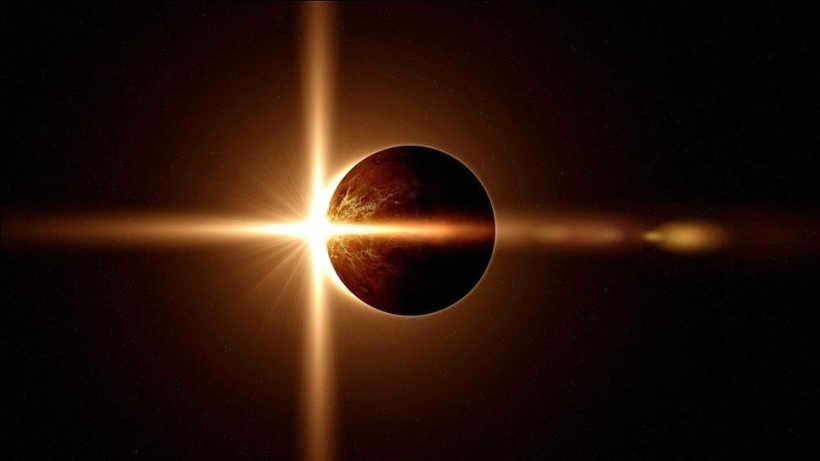
Studying the Sun
The sun is the most radiant celestial object and it is not safe to directly observe or gaze at it for extended periods. Scientists utilize specialized tools – telescopes equipped with interchangeable light filters – to examine it. To document the observed phenomena, a unique apparatus called a heliograph is employed. Essentially, a heliograph functions similarly to a telescope, except instead of an eyepiece, it is fitted with a specialized film cassette.
How to Safely Observe the Sun
It is common knowledge that observing the Sun without proper protection can be both painful and dangerous. While it may be possible to do so for a short period of time during a total eclipse, this is a rare event that only occurs about once every 300 years. A more common occurrence is a partial eclipse, where the Moon only partially covers the Sun. It is important to take precautions and use special equipment to safely observe the Sun.
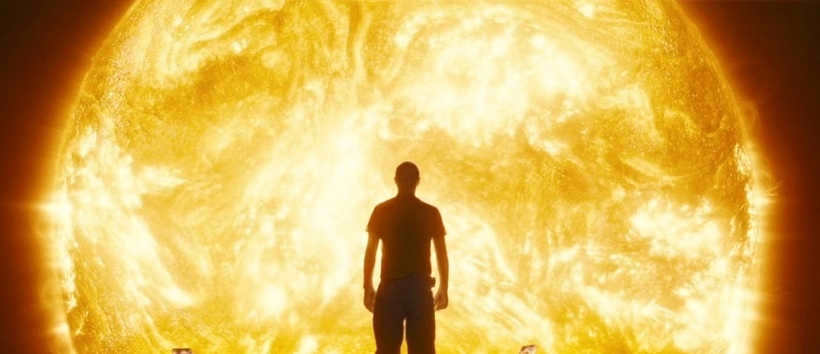
When starting the “performance,” it would be wise to equip ourselves with some gear. Therefore, let me first discuss the actions that should definitely be avoided:
- Avoid using any optics without special filters, such as binoculars;
- Avoid using regular sunglasses;
- Avoid attempting to take a “souvenir” photo without using a light filter.
In any of these situations, the best-case scenario is potential damage to the retina, while the worst-case scenario is burning the vitreous body and cornea.
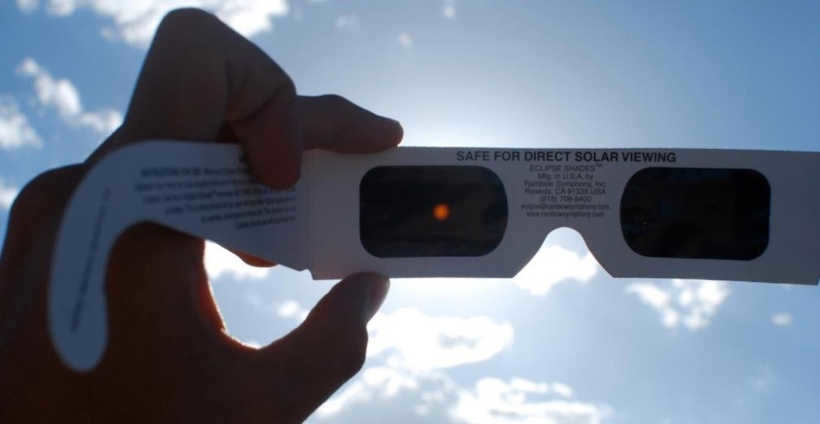
Proper Techniques for Observing the Sun
When it comes to observing eclipses and the sun in general, there are various methods that can be utilized:
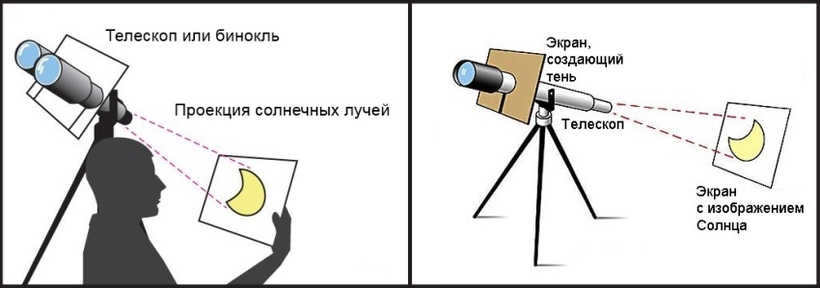
- To observe the Sun, you can buy special glasses or light filters;
- You can also use welder’s or metal worker’s goggles, which are quite effective;
- Another method is to use a regular piece of paper to see a projection of the Sun. Simply hold it in front of you at a certain distance.





